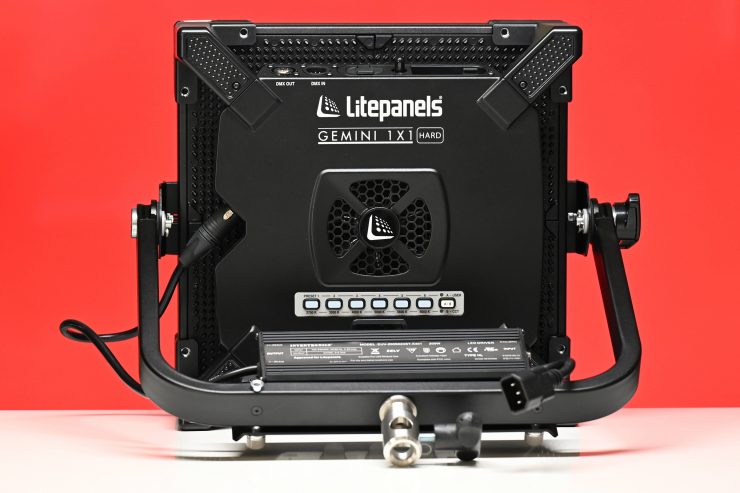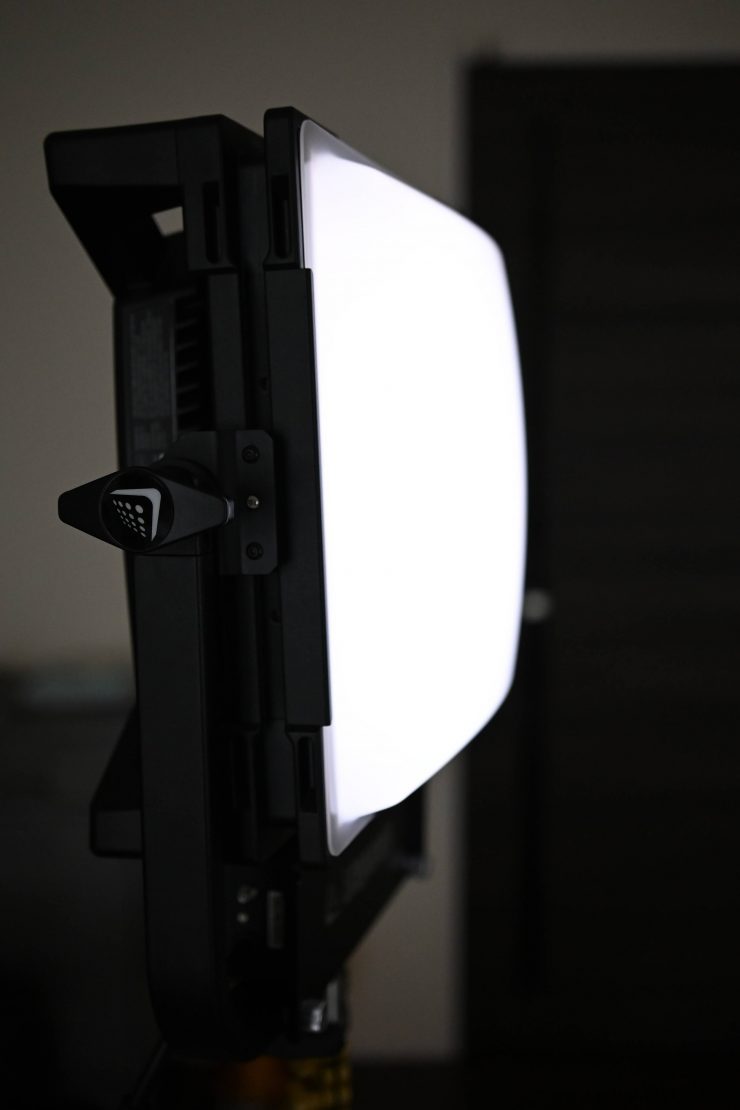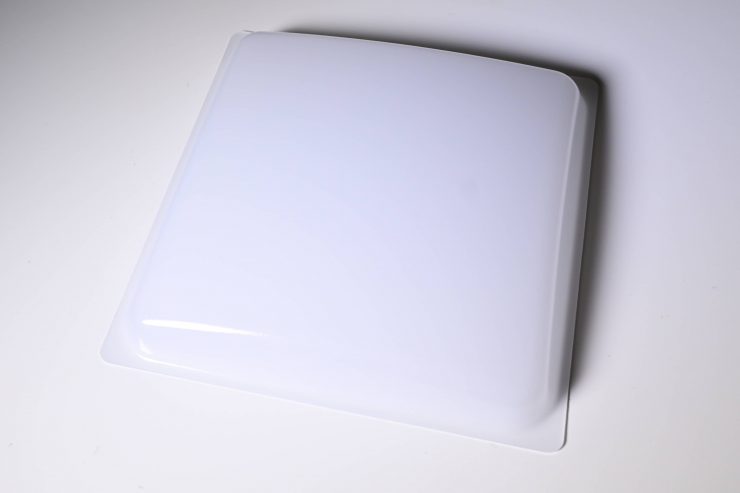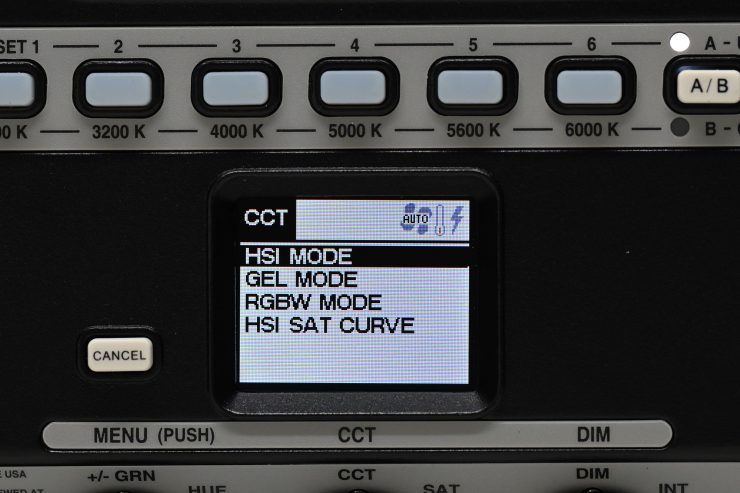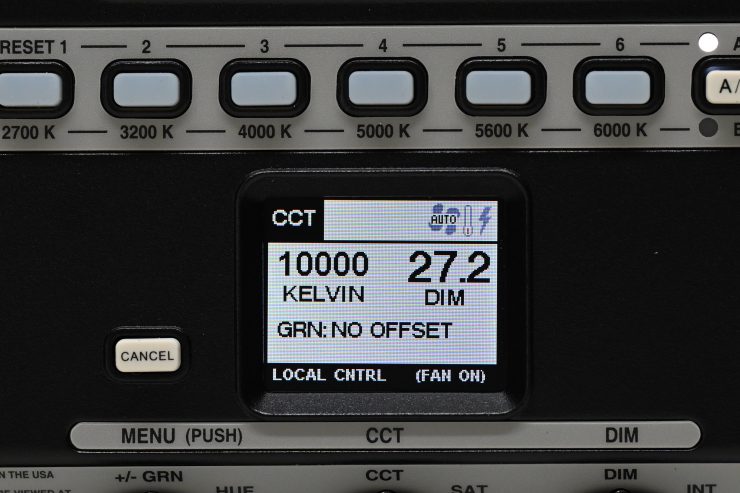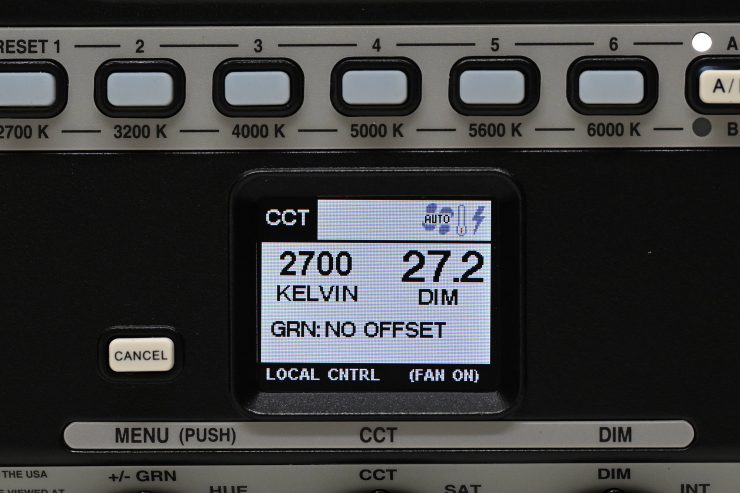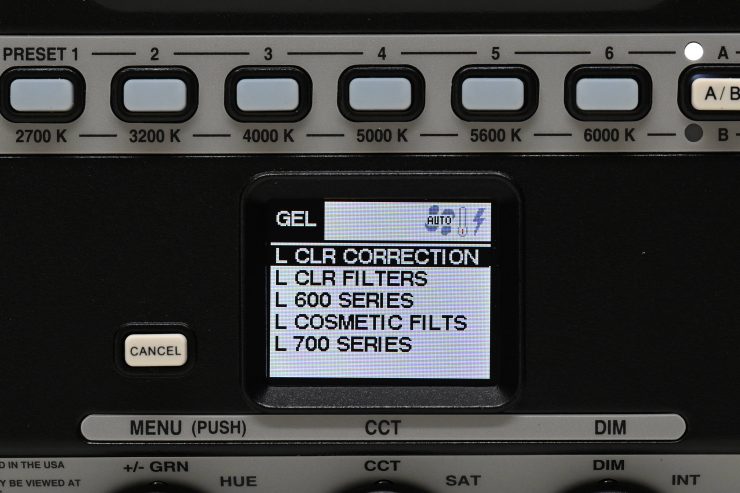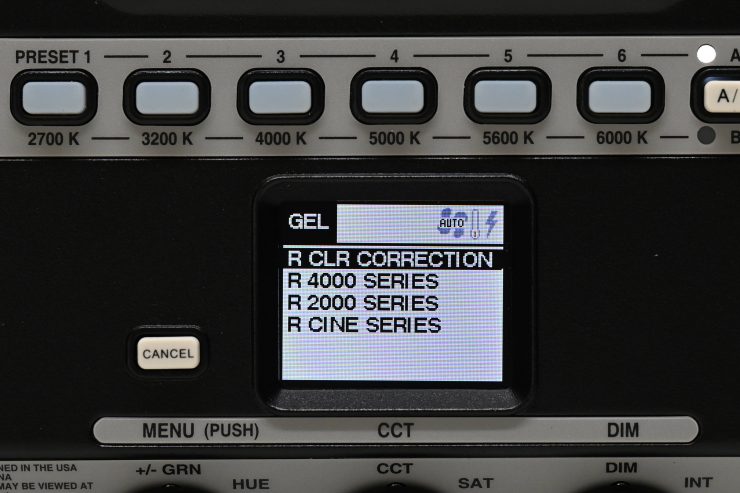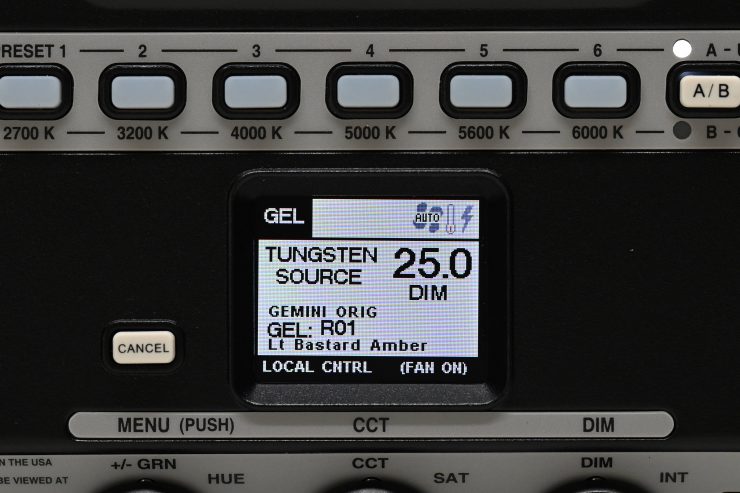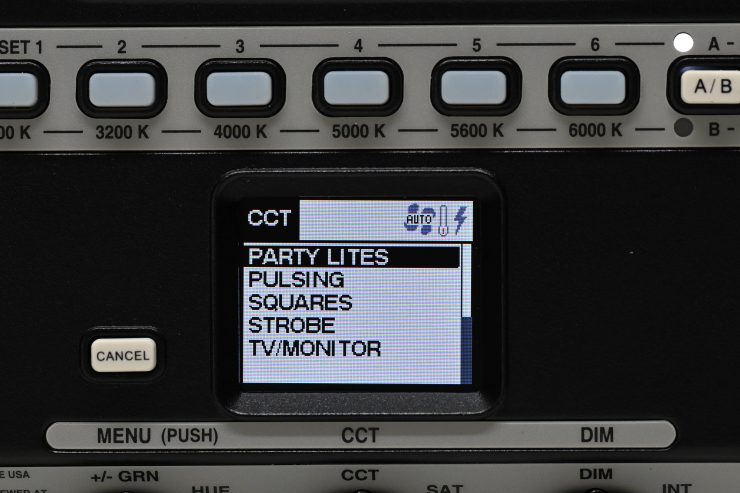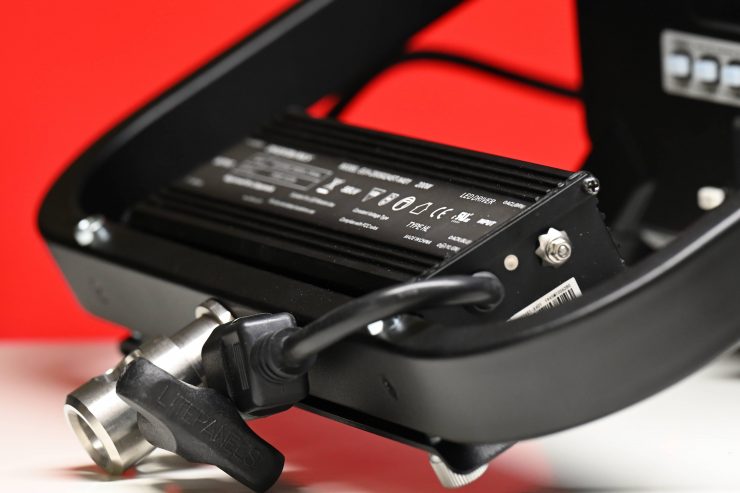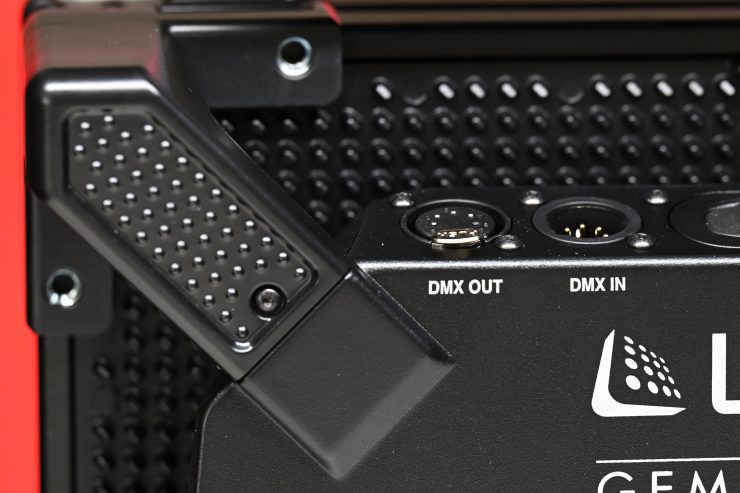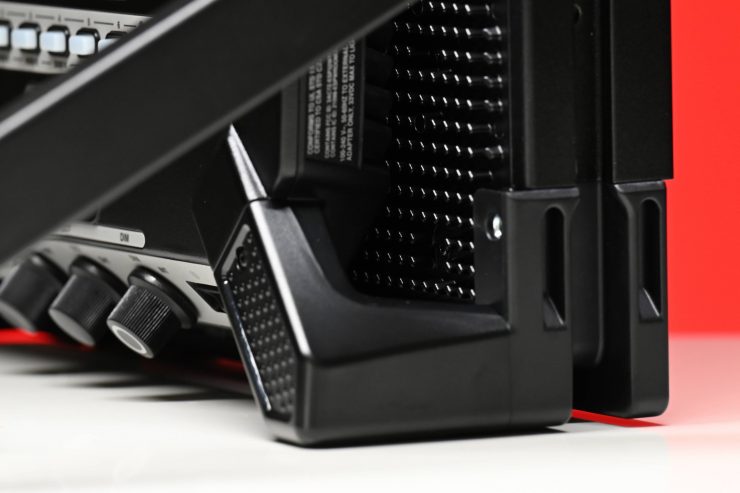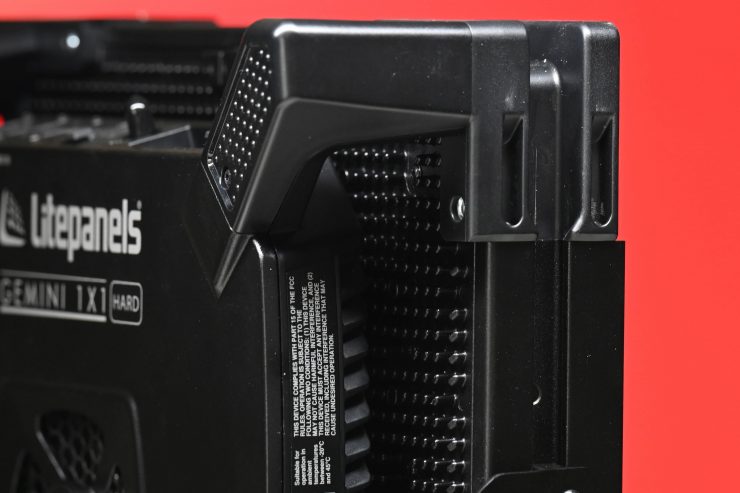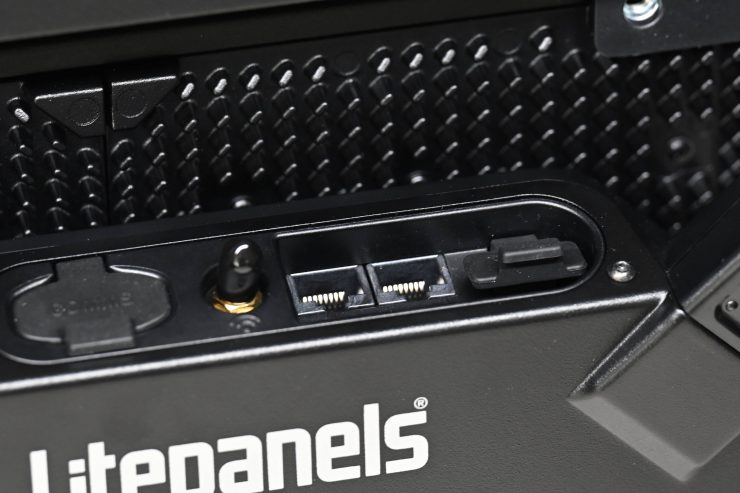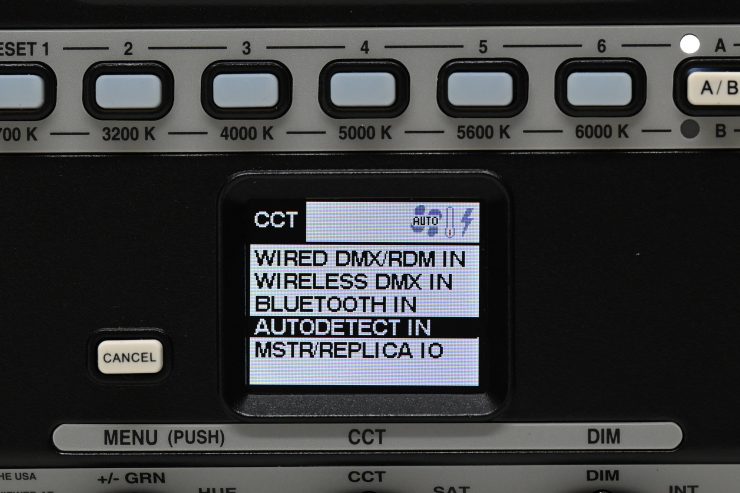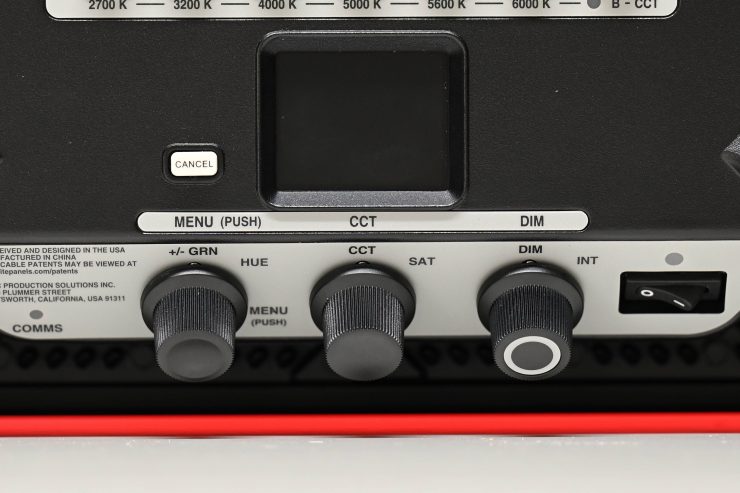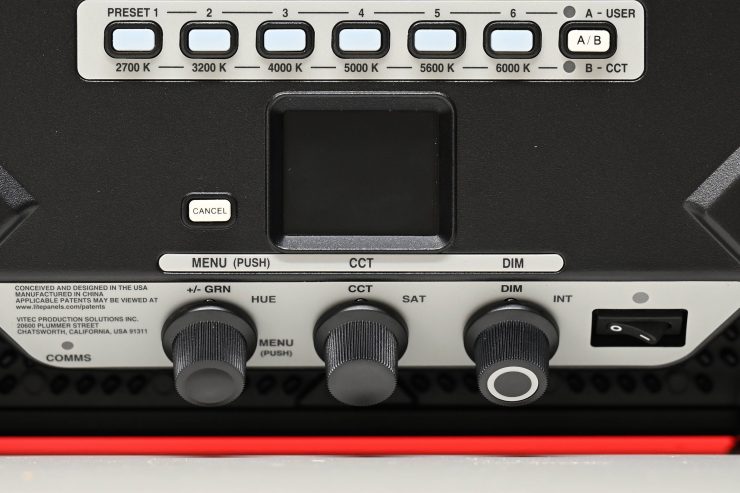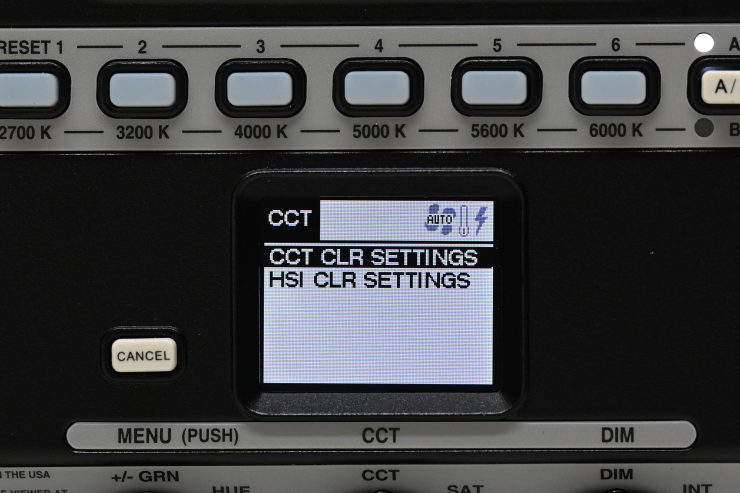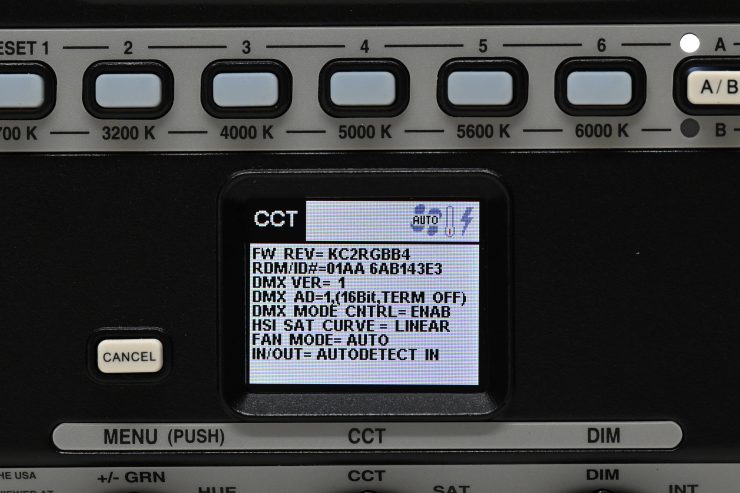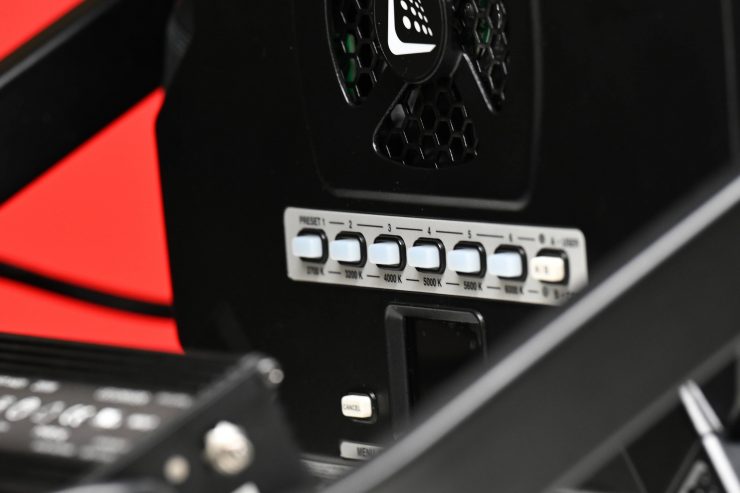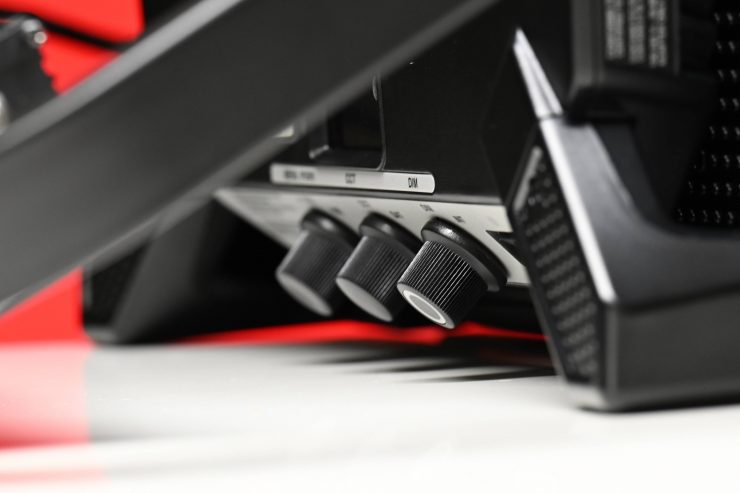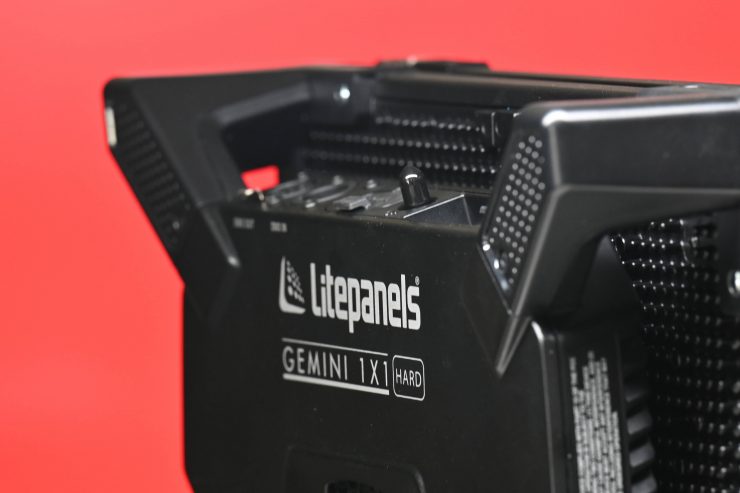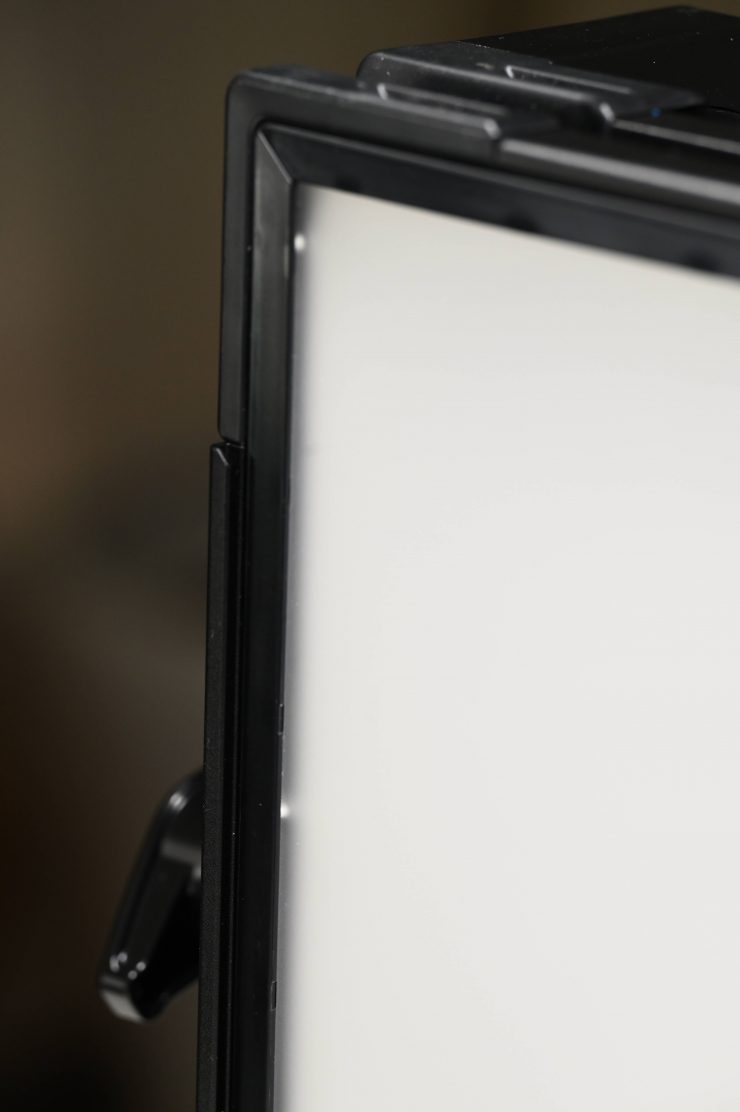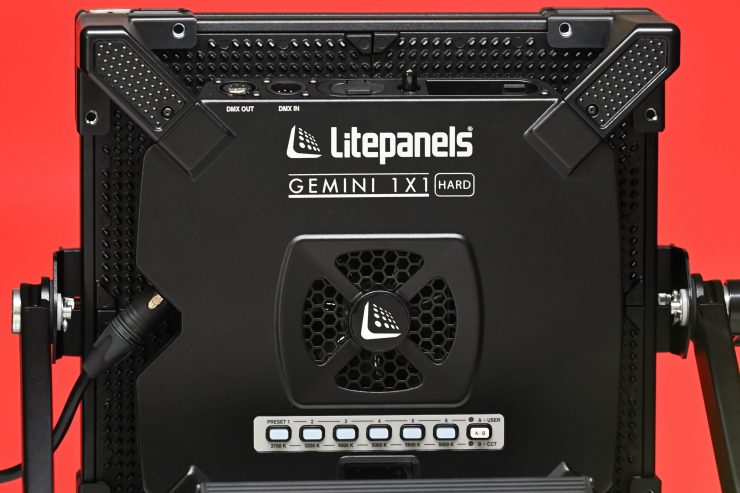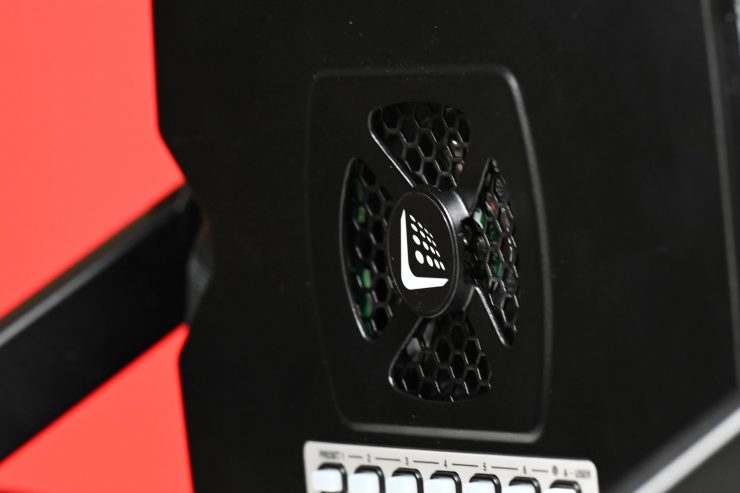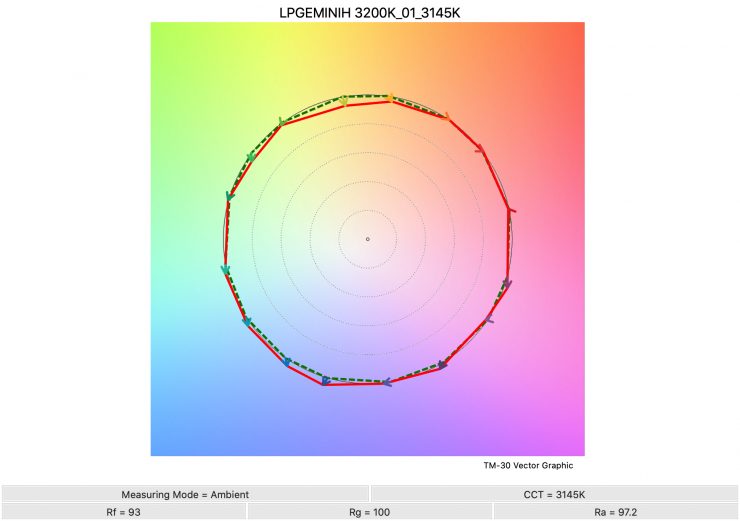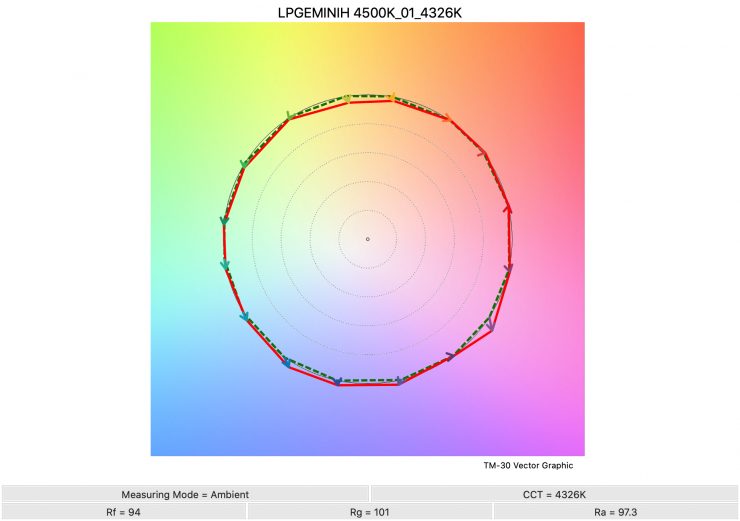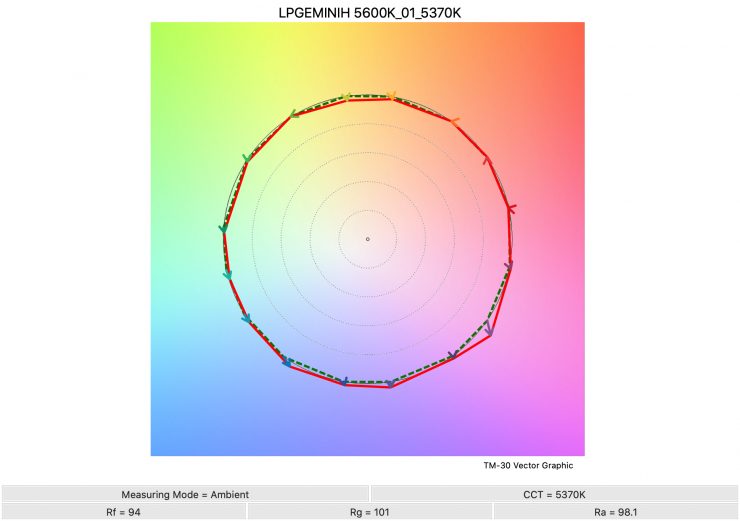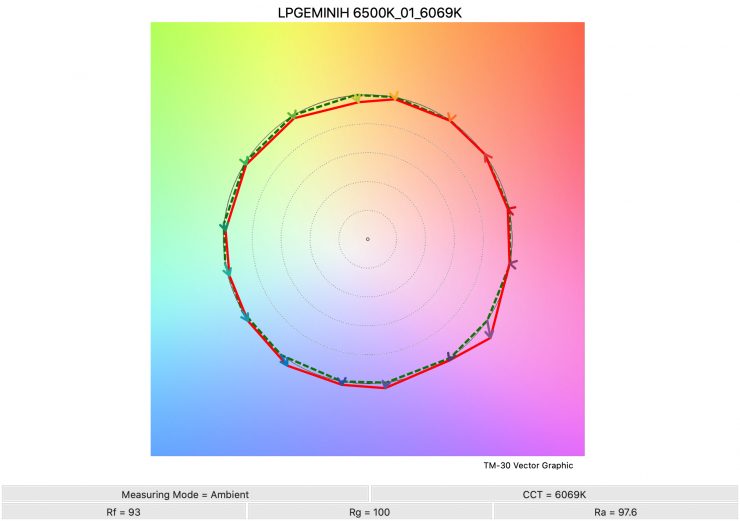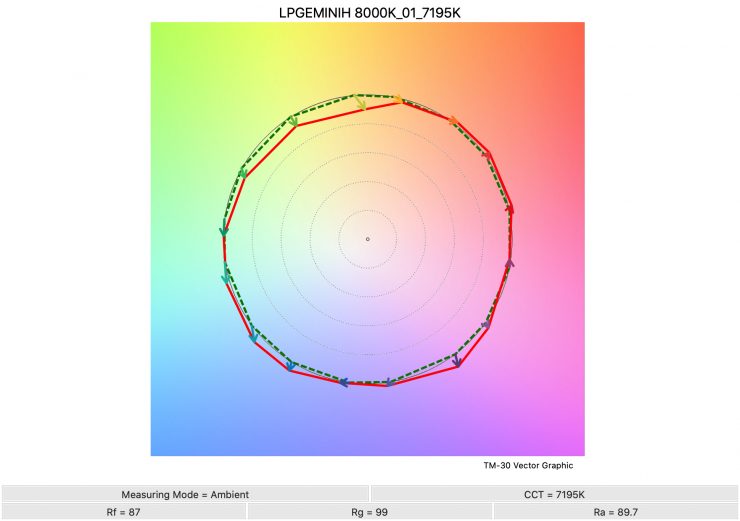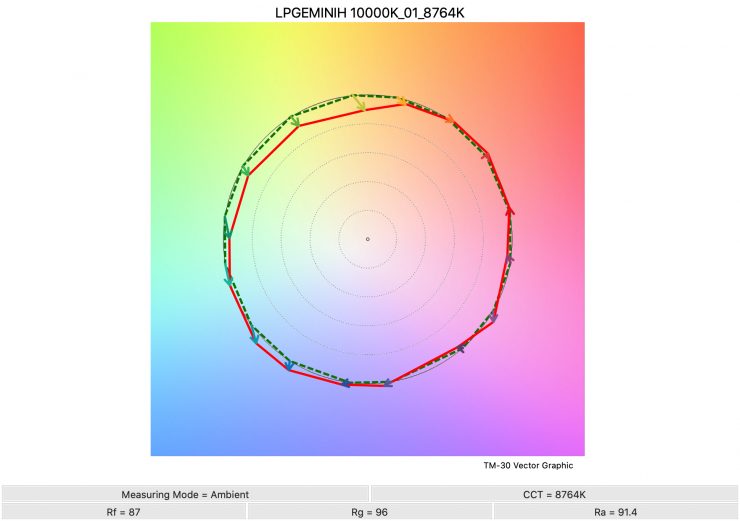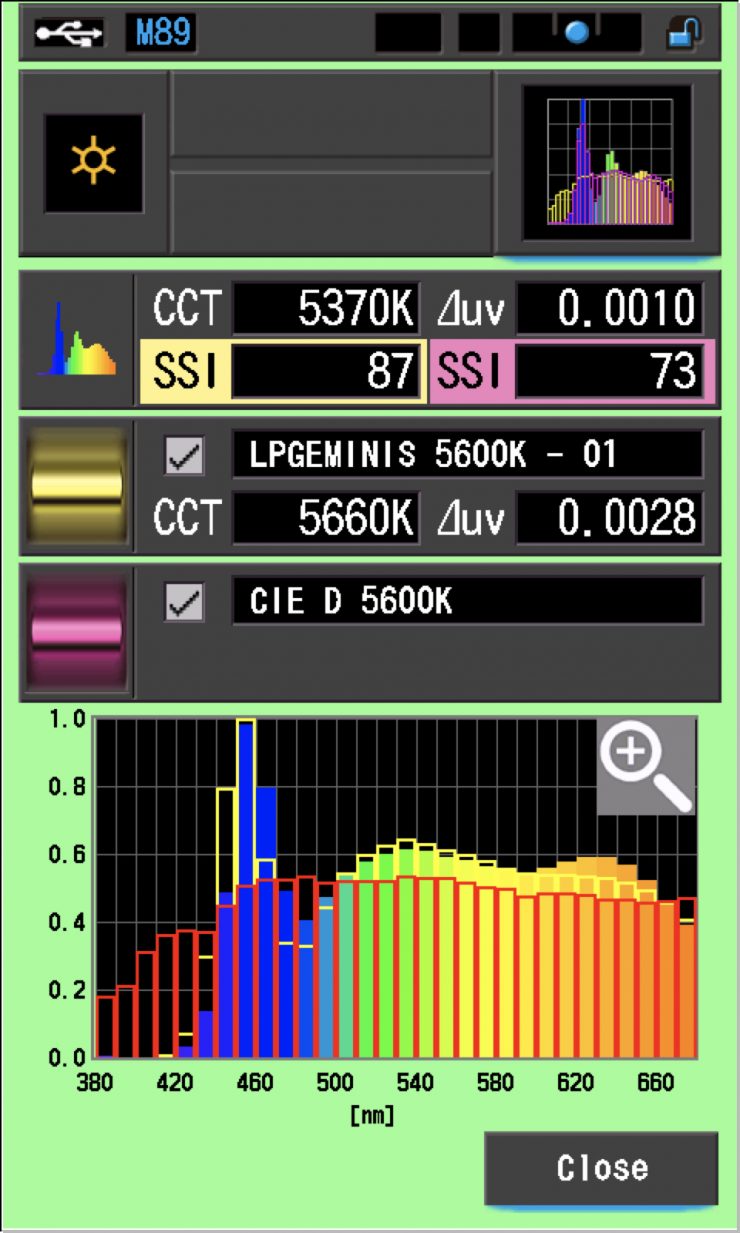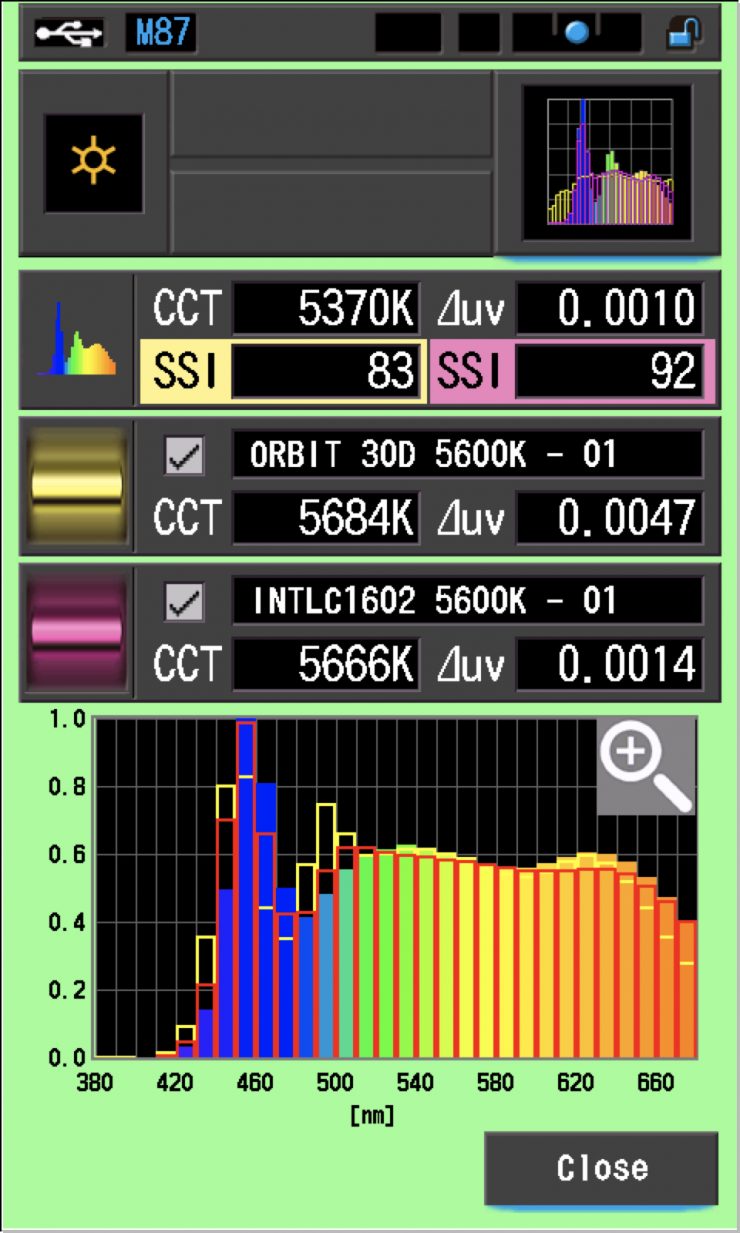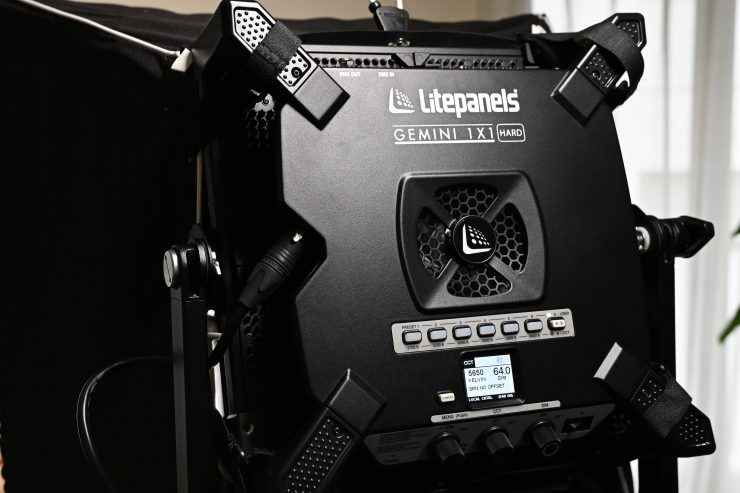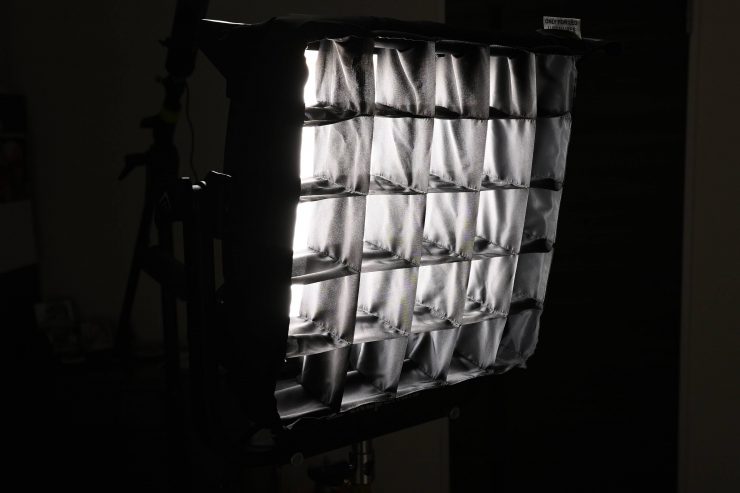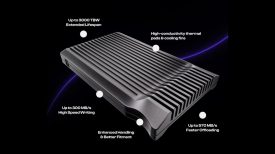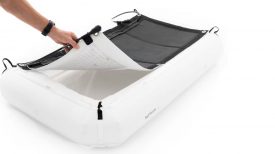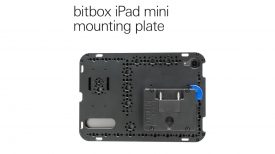
Litepanels has announced the Gemini 1×1 HARD. It has all the usual Gemini features but with much more output. According to Litepanels, it is claimed to be twice as bright as an Astra 6X.
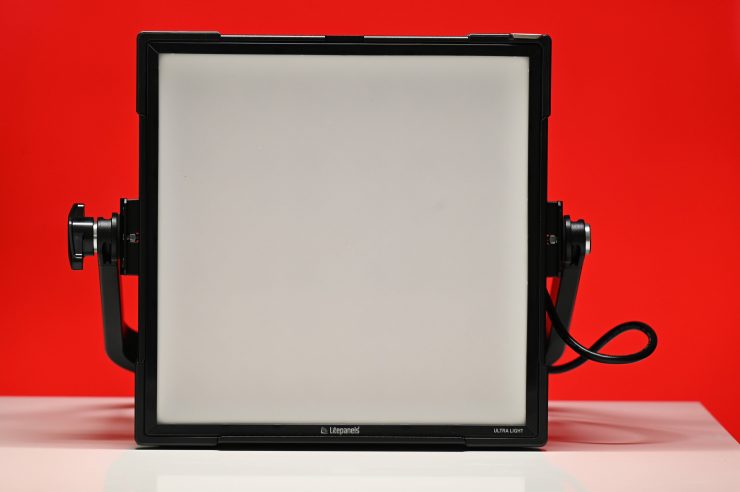
Quite a few high output RGBWW lights have come to market over the last few years so it is going to be interesting to see how the Gemini 1×1 HARD compares to those fixtures.
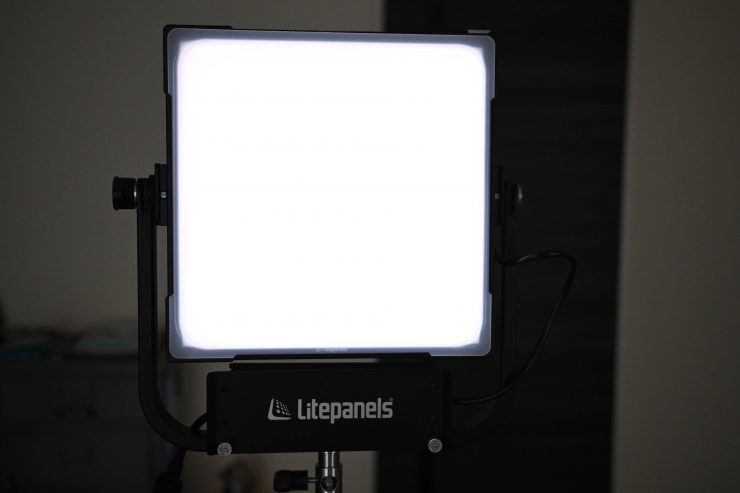
The Gemini 1×1 HARD will ship with an ultralight diffuser and a domed diffuser. This certainly increases its versatility as you can use the fixture as a hard light or a soft light.
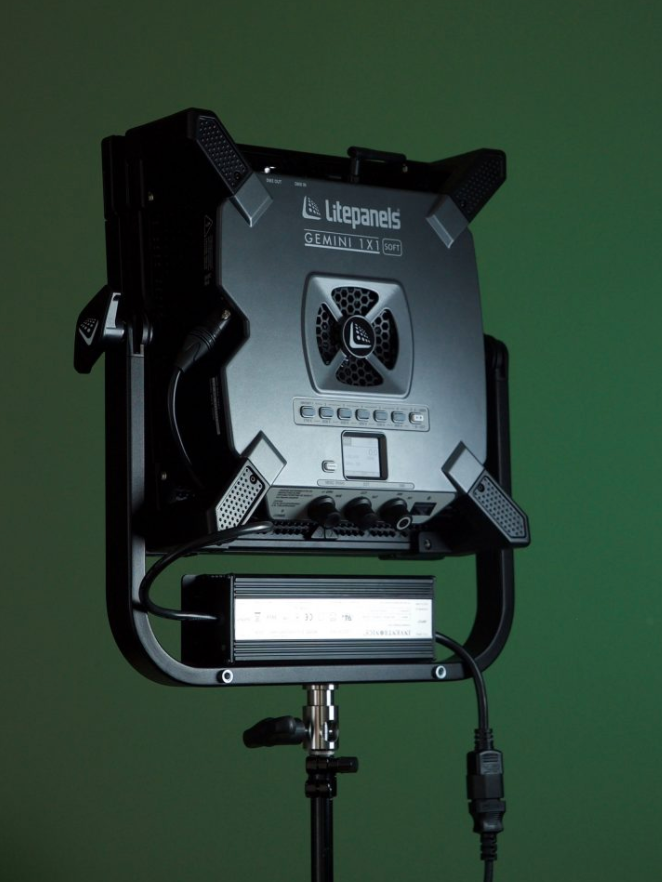
It has been around 2 years since Litepanels released the Gemini 1×1 soft and 4 years since the Astra 6X was announced.
With 1×1 panels, we have seen the evolution go from daylight battery-powered portability to Bi-Color, to in-built diffusion, to RGBWW, to high output.
Here at Newsshooter, I have been lucky enough to put the new Litepanels Gemini 1×1 HARD through its paces. So without further ado, let’s get on with it.
Key features
- Over 3,000 lux at 10ft/3m (Daylight) with a 46° beam angle
- Ultra-light and domed diffusers included for softer light in an instant
- Extended white color temperature range from 2,700-10,000K
- Claimed color accuracy, TLCI/CRI 98
- Full RGBWW color gamut mixing
- Hue, Saturation and Intensity control
- Full plus/minus green color correction
- 0.1 – 100% automatic flicker-free dimming at any frame rate or shutter angle
- Wired or wireless DMX & Bluetooth remote control options
- Multi-voltage 100-240VAC; DC Input 13-33VDC
- Optional mobile battery power with 100% intensity output
- Lightweight: 13.2lbs / 6.0kg including yoke and power supply
Meet the Litepanels Gemini 1×1 HARD
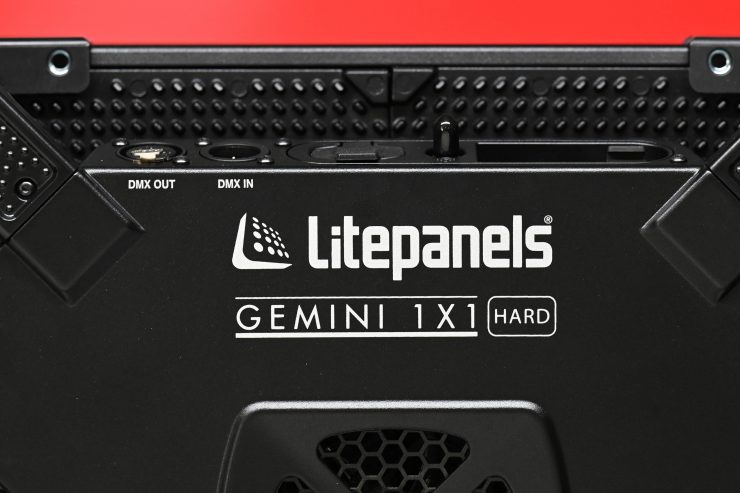
The Gemini 1×1 HARD is a panel fixture that utilizes RGB-WW. It combines daylight, tungsten, and red-green-blue LEDs. I was actually expecting the Gemini 1×1 HARD to not feature a built-in diffusion panel. Considering the claimed output of the fixture it was somewhat of a surprise.
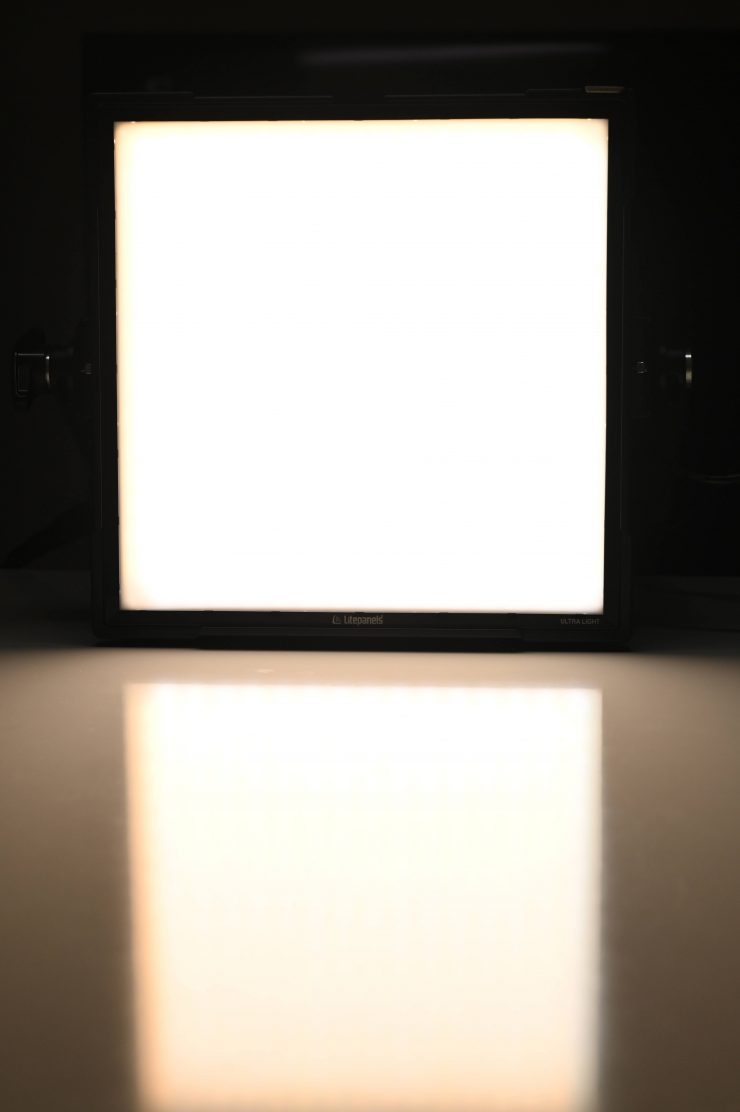
The Gemini 1×1 Soft comes with a host of features, and not only is its Kelvin color temperature adjustable from 2700 to 10000K, but it also offers four different lighting modes, 6 presets for user-defined color temperature, and plus/minus green control.
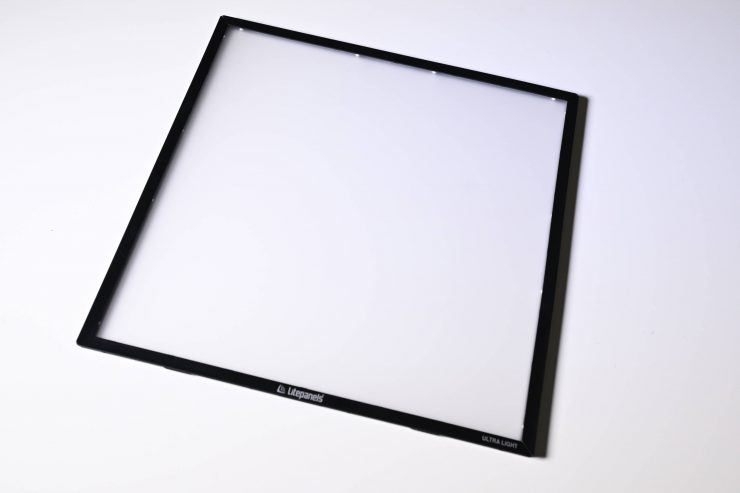
As I already mentioned, it does come with a removable diffusion panel and a Diffusion Dome. These are both super easy and quick to attach or take off.
How Does RGB-WW Work?
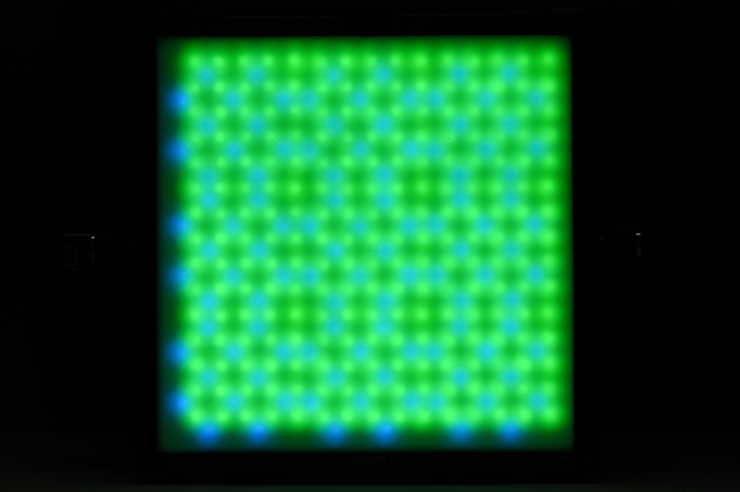
We are seeing a lot of lighting companies now use RGB-W technology. RGB-W stands for Red, Green, Blue & Warm White. Most LED lights on the market create white light by mixing red, green, and blue, which unless it is done well, can create undesirable color spikes. With most RGB-W, an extra white chip is added into the mix. By mixing all four, a wide range of colors can be created and in theory, the light produced when all four are at full brightness should appear to be almost white. With the Litepanels Gemini, the fixture is RGB-WW, and they use 5 chips, not 4. The extra chip means the Gemini not only has a warm white chip, but also a white chip. This is different to say the ARRI SkyPanel where they are actually mixing colors to obtain white.
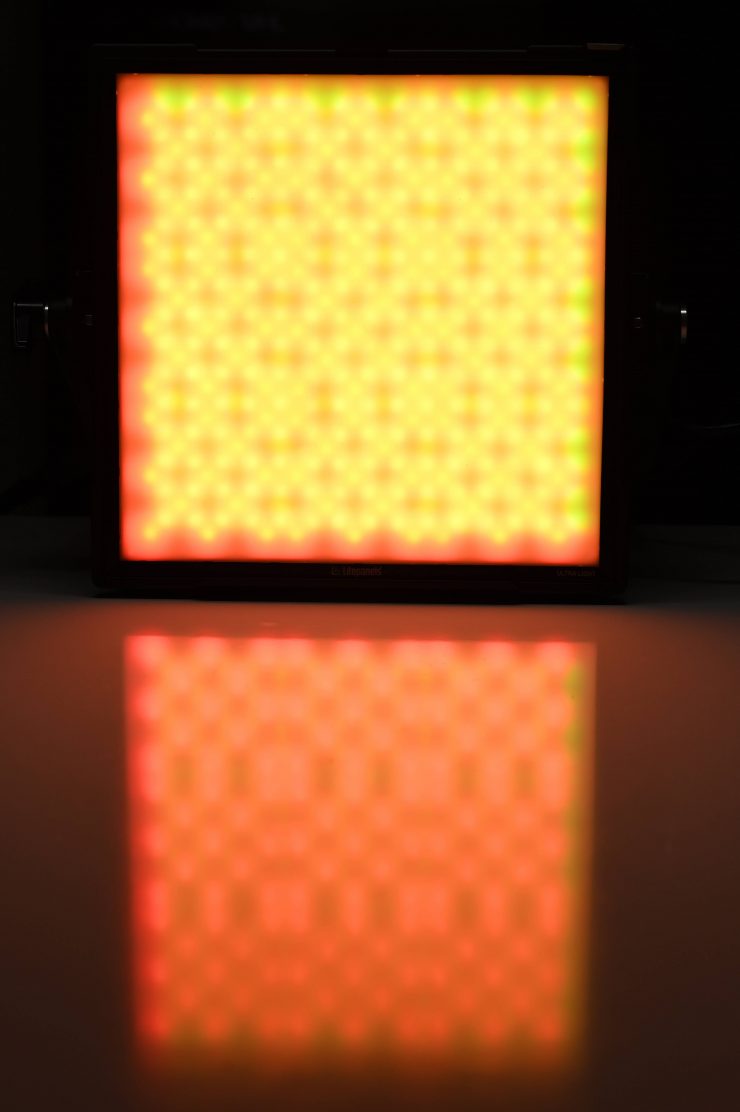
RGB-WW and RGB-AW have become increasingly more common as far as LED lights go. They are a lot more expensive to produce than regular RGB LEDs. While in theory, an RGB-WW LED should be better at creating color mixes, it requires significantly more cooling than a regular RGB LED.
Litepanels claim that the Gemini has been designed to give users a daylight-to-tungsten light foundation that then enables them to finely adjust color throughout the full, 360-degree color wheel. The philosophy behind doing it this way is that users should be able to match a broad range of ambient lighting conditions with more ease. For example, if you were shooting in a room that had a lot of overhead fluorescent lighting which you couldn’t turn off, you could, in theory, add or remove green, or use an in-built digital filter to try and get your fixture to match more closely to the ambient lighting conditions.
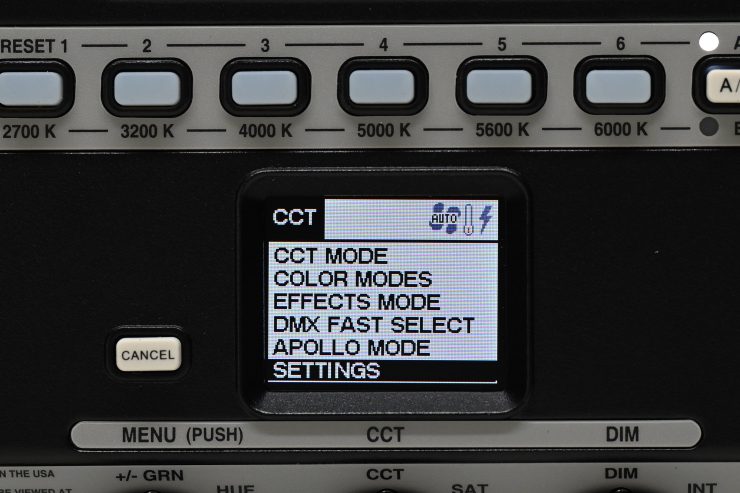
Gemini offers four lighting modes:
Correlated Color Temperature (CCT) Mode
Allows bicolor (daylight to tungsten) with +/- green adjustment.
Color Mode
Offers hue saturation and intensity (HSI) control for full color and saturation control
Gel Mode
Provides the ability to dial up a variety of popular gels.
Effects Mode
The ability to create lighting effects such as Fire, Lightning, and Emergency.
Correlated Color Temperature (CCT) Mode
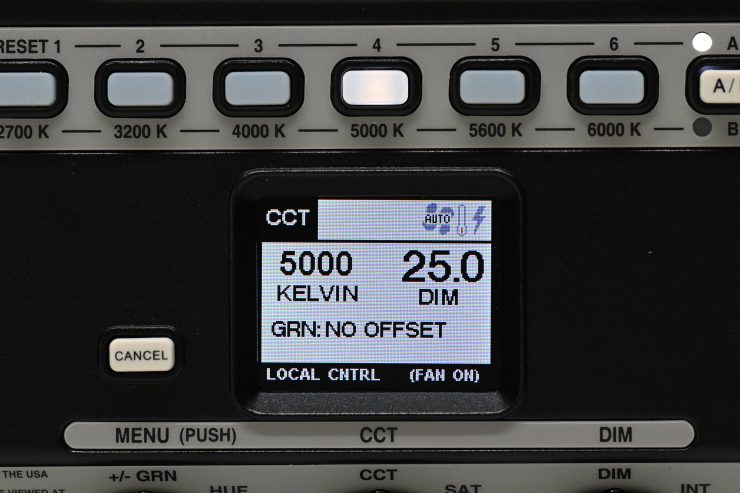
This is the mode most people are going to use the light in the majority of the time. In the CCT Mode, you have full access to making Kelvin color temperature adjustments between 2700K to 10000K. These adjustments can be made in increments of 10K.
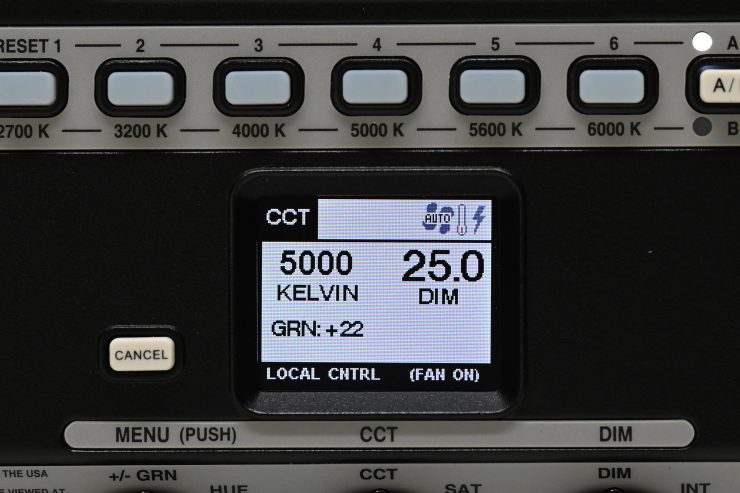
You also have full +/- green adjustment available which is extremely handy. Being able to dial in more or reduce the amount of green coming from your lighting source can make a huge difference. Different camera companies use different sensors in their cameras and they all react differently to light. Some camera sensors may lean towards magenta, and some, more towards green. By making CCT adjustments you can dial in the light so that it looks better for whatever camera system you are using.
The Kelvin color temperature range is impressive and it puts the Gemini in line with other lights such as the ARRI SC30-C, Luxli Timpani, Rotolight Titan X1, and Lupo Superpanel Full Color 30 that all have the ability to operate up to 10000K.
Color Mode (HSI)
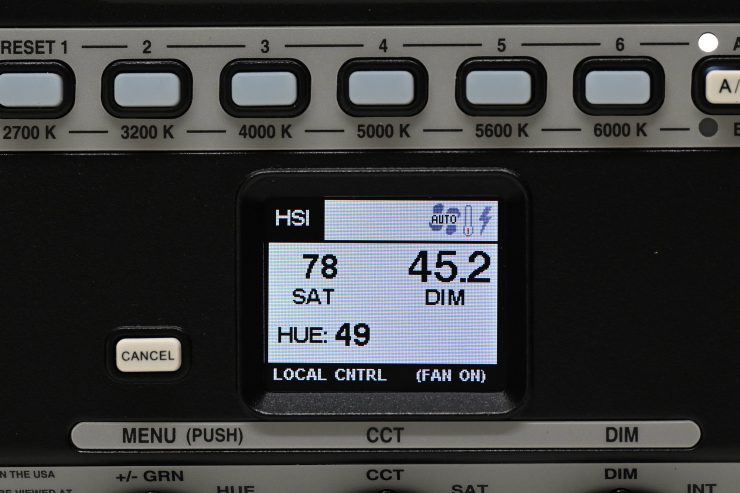
The HSI mode lets you create just about any color you can think of. It gives you full hue and saturation control as well as intensity. By manipulating, the hue and saturation you can create some really interesting colors that depending on the project you are working on can really add some creative flair. I quite like using this mode to create a lot of color separation between the foreground and background, or for recreating a really cold or warm looking image.
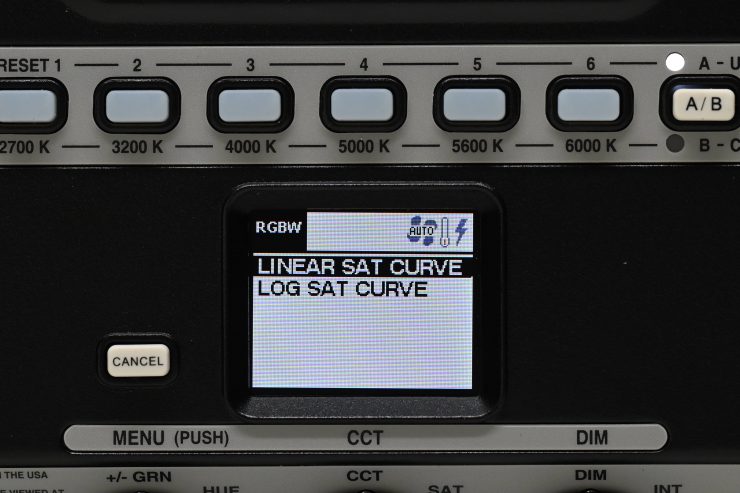
You can also change the HSI SAT CURVE
Gel Mode
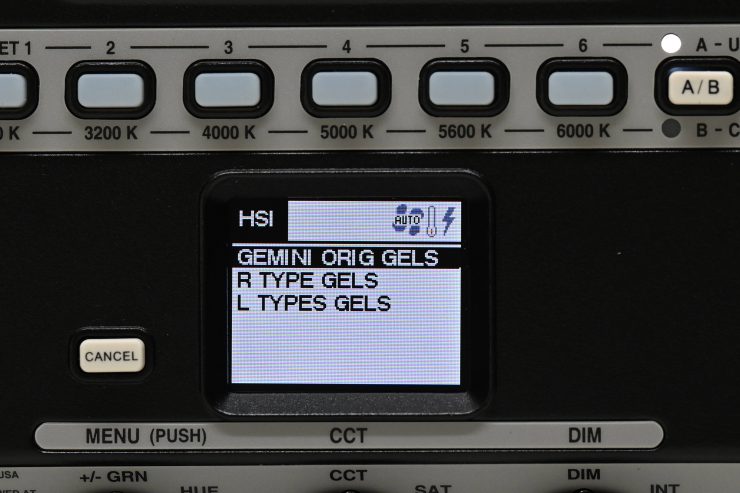
Gel Mode is a fantastic feature that lets you replicate popular Rosco gels (there are a couple of LEE ones as well) depending on whether you have the light set as either a tungsten or daylight source. Using the gel mode can help you match other lighting sources, especially if you are working with other lights with gels. There are over 300 gels to choose from.
Effects Mode
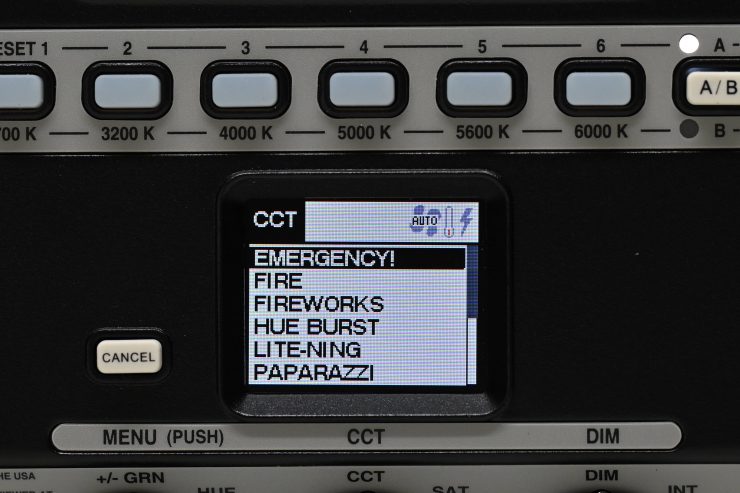
As the name suggests, this mode lets you recreate a wide range of lighting effects which can be handy for certain scenarios. The effects include:
Emergency
Fire
Fireworks
Hue Blast
Lightning
Paparazzi
Party Lights
Pulsing
Squares
Strobe
TV/Monitor
All the effects modes can be individually adjusted and tailored to your lighting needs.
While all these options are great, they are hardly revolutionary features. +/- green adjustment, hue, saturation and intensity (HSI) control, the ability to dial up gels, and lighting effects have been available in the Arri SkyPanel series and quite a few other RGBW lights for quite some time.
Design
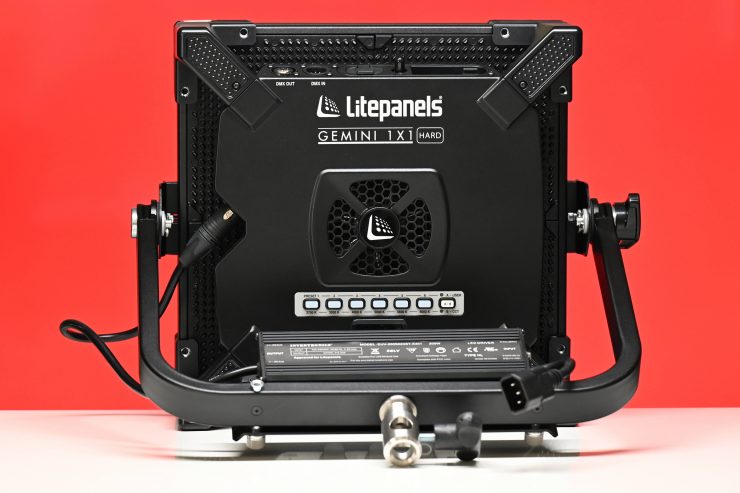
Even though it is a 1×1 panel light it does feel a little larger than some other 1×1 LED lights, even though technically it’s not. A lot of this has to do with the fact that the power supply is attached to the yoke frame. In some ways, I like the fact that they have incorporated the power supply into the yoke frame as it makes setting up and using the light really quick.
You can remove the bracket that has the power supply attached to it, but the cable is relatively short, so you can’t just place it on the ground. Litepanels really should have included some sort of extension cable so you could place the power supply on the ground and still be able to run a cable up to the light. I like the placement of the LCD display screen and where they have positioned all of the buttons and switches. Everything is easy to access.
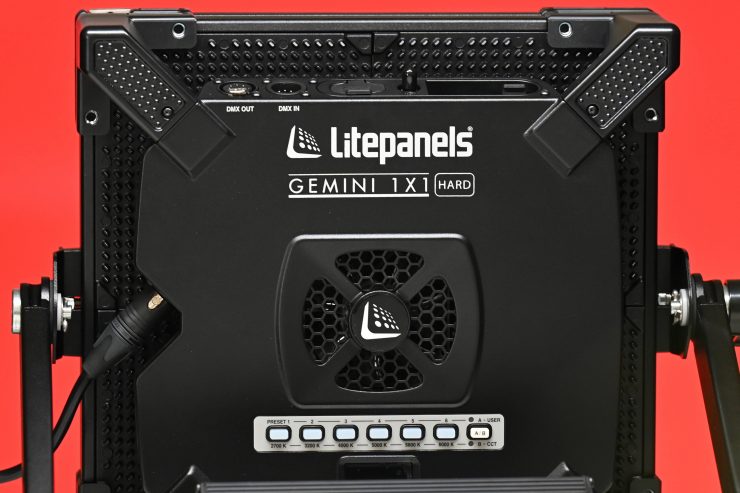
Litepanels has designed the light so that the front panel and the rear control unit are separated. They are connected together via sort of pseudo handles on the back of the light so that you can handhold it. While they do work, they are a little difficult to grasp, and given the weight of the fixture, you aren’t going to be able to hold it for extended periods of time.
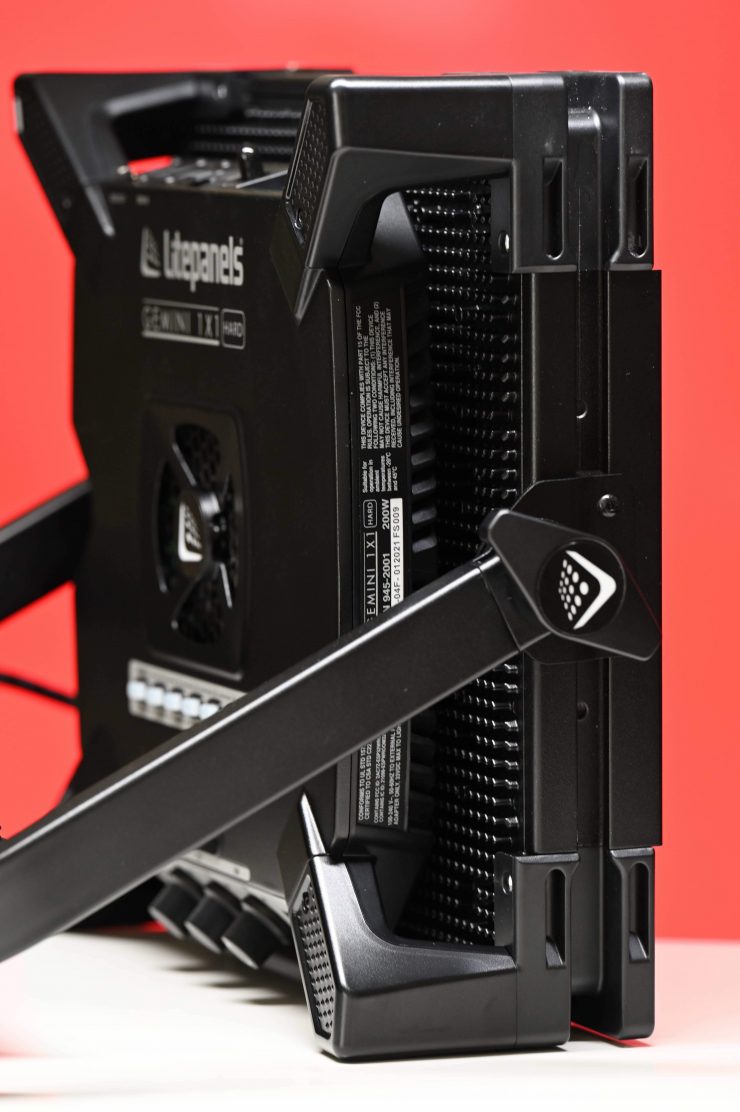
The light’s design is exactly the same as that of the Gemini 1×1 SOFT. It is a little unusual to look at (that’s neither a good or a bad thing) and it looks like it could be used as a prop on a science fiction movie.
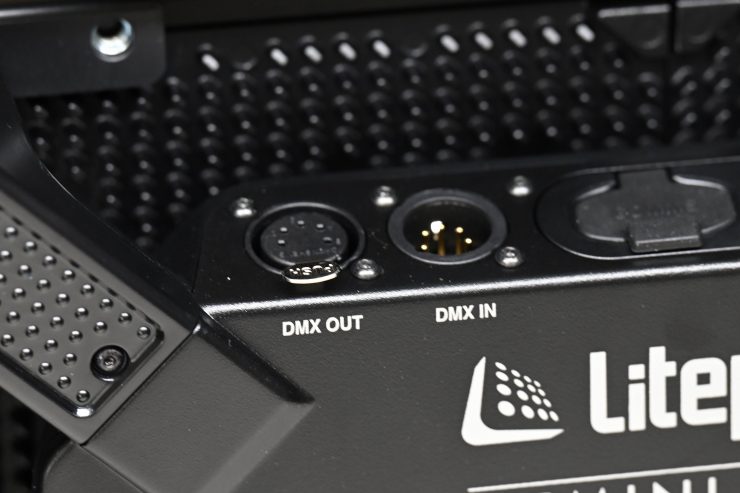
Litepanels do offer remote control through DMX (5-pin XLR or RJ45), Wireless DMX (both using standard 512 protocol), or Bluetooth. If you use Bluetooth, the Gemini 1×1 HARD can be remotely controlled using the Litepanels SmartLite or SmartLite Director apps that are available for iOS devices, but you will need to purchase the optional LYKOS Bluetooth Dongle ($99 USD).
The light does have built-in WiFi. According to Litepanels, the firmware hat will enable this will be avilable soon.
Controls & Operation
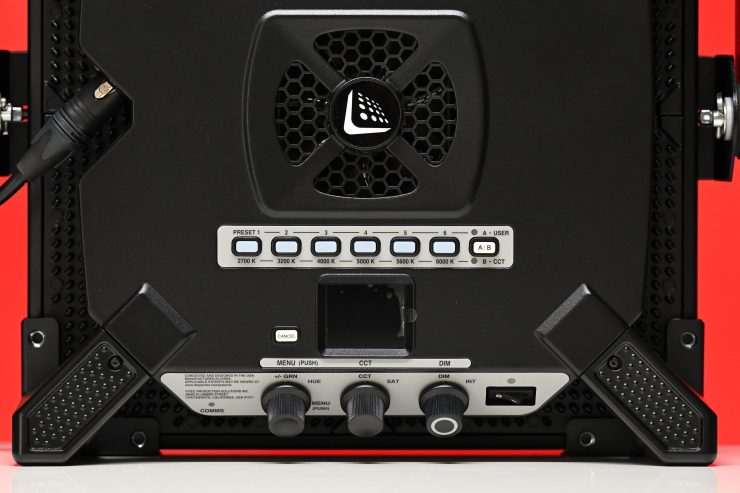
I really like the controls and menu system on the Gemini series. Everything is easy to access, and the menu system is straightforward and easy to use. The buttons and dials are clear and easy to read and the in-built LCD display shows you exactly what you need to see. The dials have little notches on them so when you make adjustments you get a nice tactile feeling.
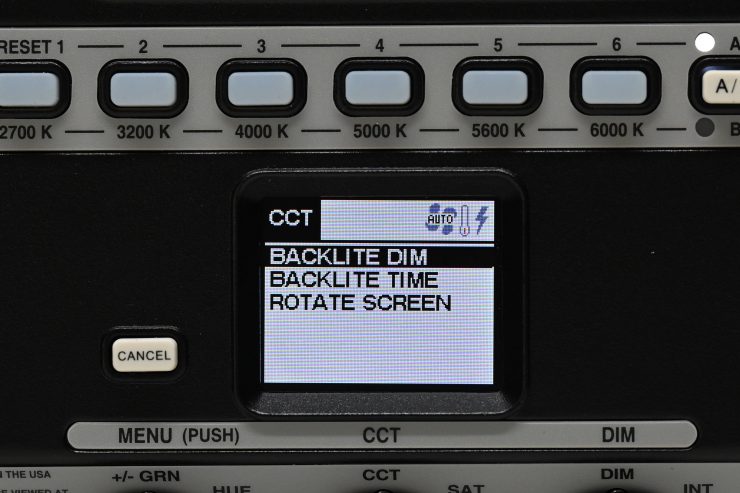
You can also choose top dso things such as rotate the LCD screen if you are using the light upsiode down, or change the brightness of the screen or change how long it stays on for.
The control layout is simple, responsive, and easy to use. While it may not have the touchscreen functionality and flash of the Rotolight Titan X1, it is a solid system that works well.
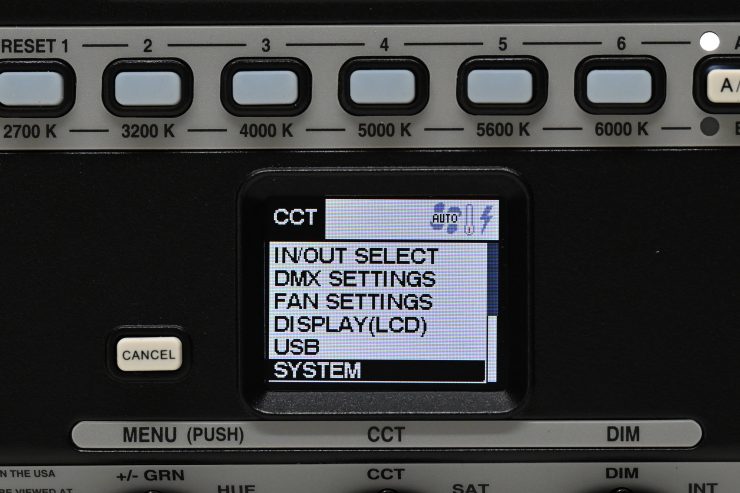
As far as other menu options go, there are quite a few choices.
Preset Buttons
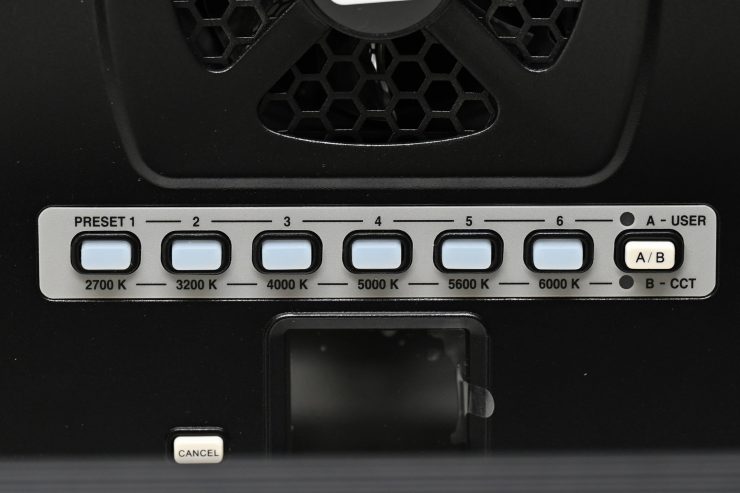
The Gemini has six preset buttons that can be used in the default mode as Kelvin color temperature presets: 2700K, 3200K, 4000K, 5000K, 5600K, and 6000K. There is also an A/B switch that changes the 6 buttons into User Presets. With User Presets you can store your favorite settings or lighting effects and recall them instantly. This is really handy if you are working with certain cameras and you have pre-dialed in a look that you know works well with that camera. You can just store it and then bring it up the next time without having to adjust all the settings. This saves precious time and allows for accurate repeatability with your lighting.
Build Quality
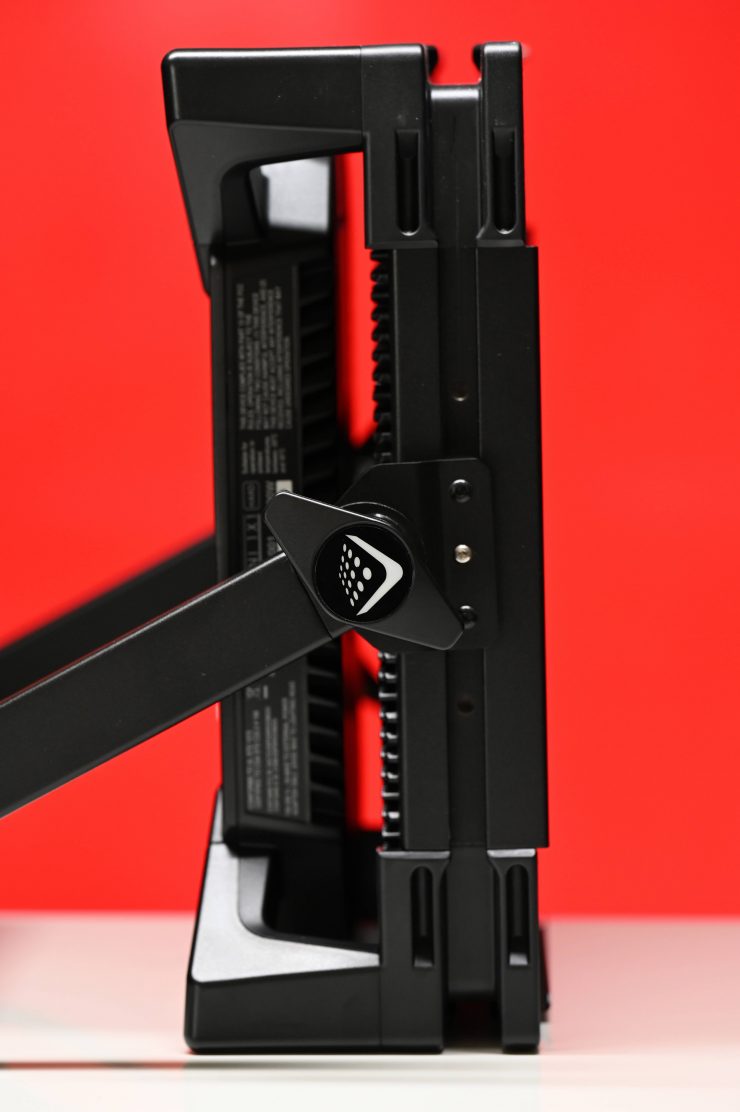
Litepanels has come a long way since the original 1×1 Litepanels. The build quality has improved over the years and on the surface, the build quality of the Gemini series is far better than the Astra series. While I don’t personally think it is as well made as the larger 2×1 Gemini the overall build quality is pretty good. The housing is more robust and solid than previous Astra 1x1s.
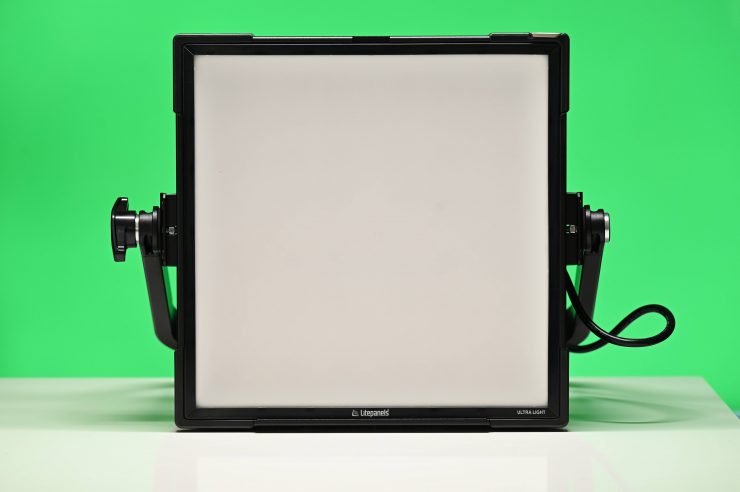
The Gemini 1×1 SOFT and 1×1 HARD are made on the same production line using the same materials as the Gemini 2×1.
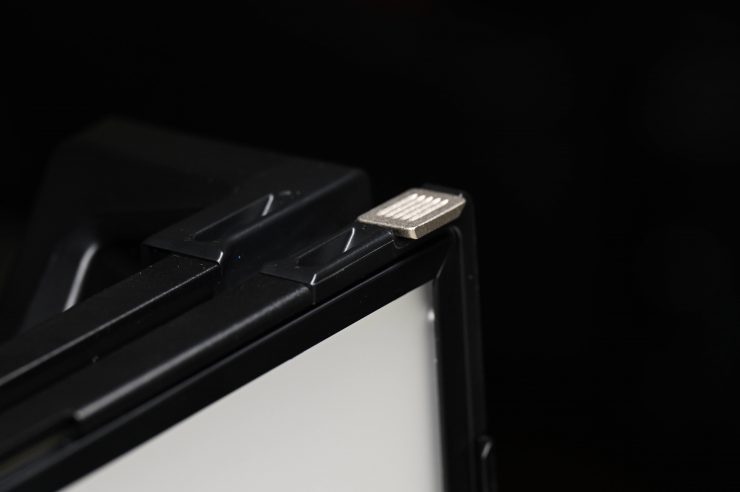
The light has a built-in accessory rail for inserting honeycomb grids, barn doors or a softbox. This is quick and easy to use.
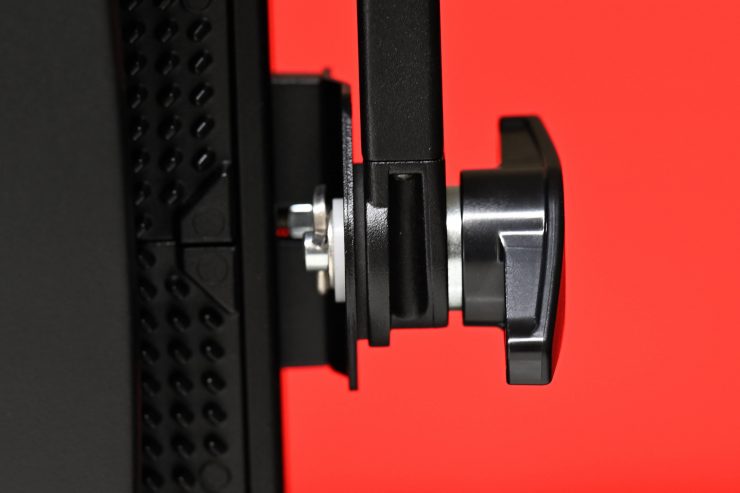
The yoke frame is nice and robust and offers a full range of rotation. It does lock-off securely, but I would have preferred to have seen a dual locking mechanism. In my opinion, having two is always better as it makes it easier to remove the yoke frame from the fixture. Often if you are traveling you may want to remove the yoke frame so that the light can be placed in a smaller bag.
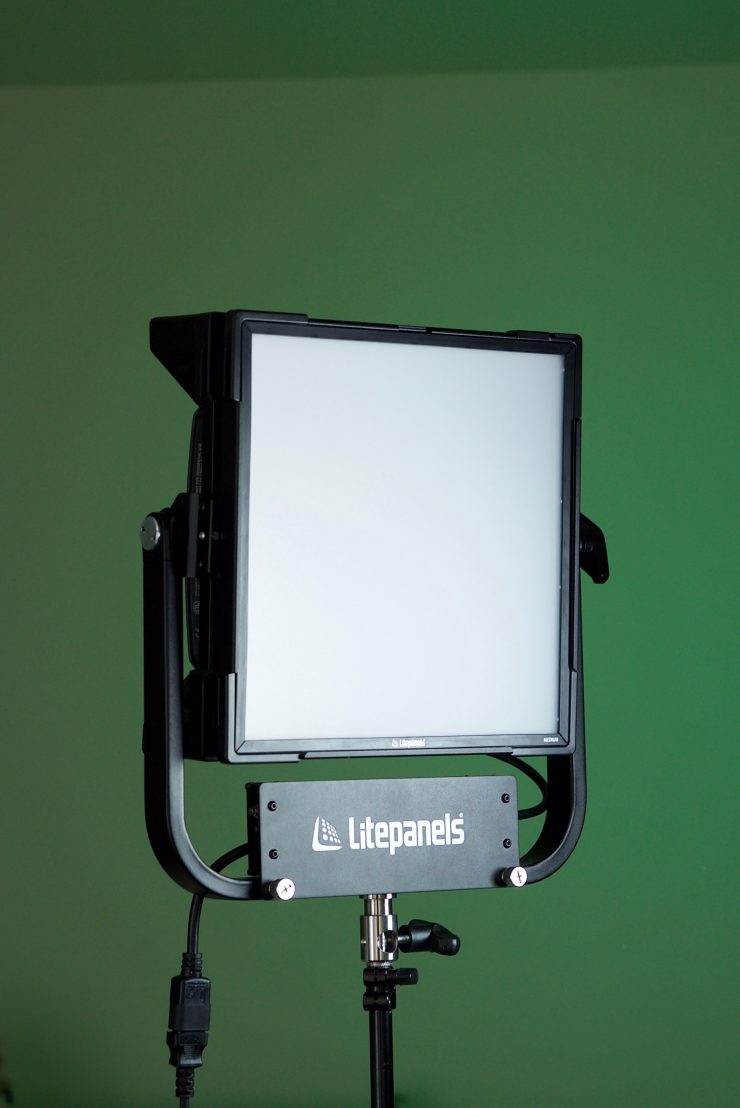
I have been using the original Gemini 1×1 SOFT for the last 2 years and it has been a rock-solid light.
Fan Noise
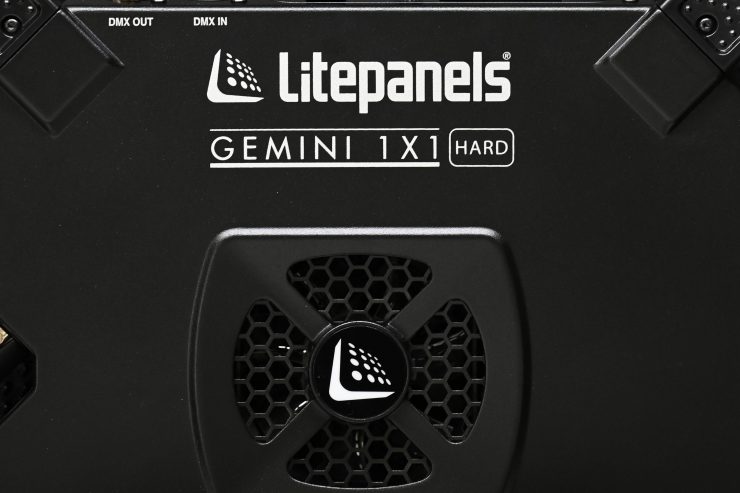
The Gemini 1×1 HARD does use a fan to cool the fixture. So does it make much noise? From my testing I didn’t find it to be a problem, it’s barely audible even in the quietest of rooms. Even after leaving the light on for long periods of time it didn’t get noisy.
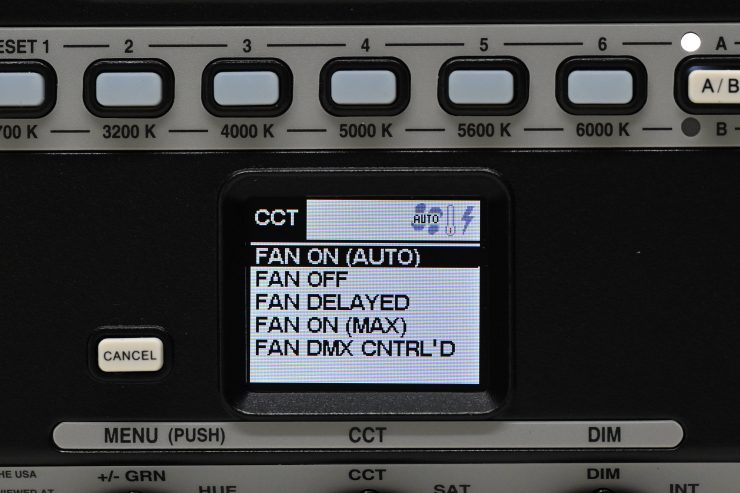
You can choose various different fan modes if you want to. I just tended to leave it on auto.
The combination of heat sinks and a fan really does seem to work well. The light
Size & Weight
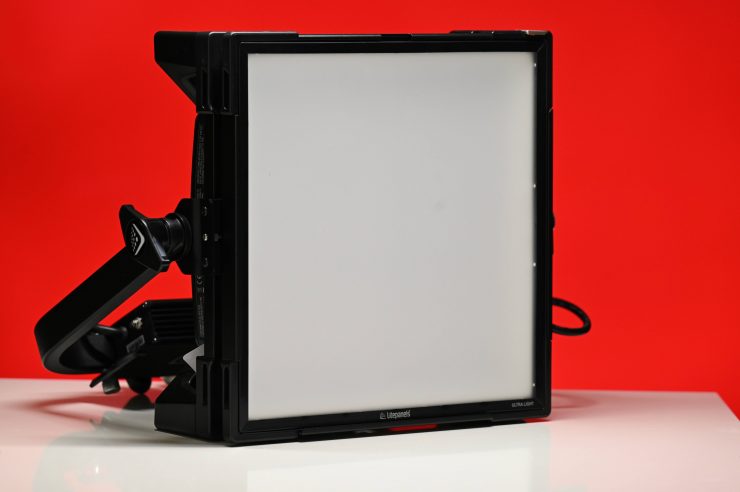
The Gemini 1×1 HARD has dimensions of 16″ x 18.5″ x 4.7″ and it weighs in at 6 kg (11.7lb), which is certainly on the heavy side for a 1×1 fixture. It is around 700g heavier than the Gemini 1×1 SOFT.
Part of this weight is due to the large cooling system that is required when using RGB-WW LEDs. The Gemini not only has a large fan, but the back of the fixture is essentially one large heat sink.
Given its feature set and build quality, the weight is well controlled. Would I have liked it to weigh less? Of course, but then that probably would have resulted in the build quality being compromised. It’s always a trade-off with lights like this, but in my opinion, I’d rather the light be heavier, well made and robust than lighter and made out of cheaper components.
So how does this weight compare to some other high output 1×1 RGBW lights? Below you can see:
| Weight | |
| Litepanels Gemini 1×1 HARD | 6 kg* |
| Rotolight Titan X1 | 12.2 kg (including power supply) |
| ARRI S30-C SkyPanel | 10.3 kg (including power supply) |
| Litepanels Gemini 1×1 SOFT | 5.31 kg* |
| Rayzr 7 MC120 | 3.63 kg* |
| Lupo Superpanel 30 Full Color | 3.7 kg* |
| Luxli Timpani 1×1 RGBAW | 3.37 kg* |
| Aputure Nova P300C | 10.35 kg / 22.82 lb (Including Yoke, Cable, Frame, Mount, Receiver) |
*These lights have built-in power supplies.
As you can see it is heavier than the fixtures from Lupo, Luxli, and Rayzr 7, but quite a bit lighter than the ARRi, Rotolight, and Aputure.
Power Draw
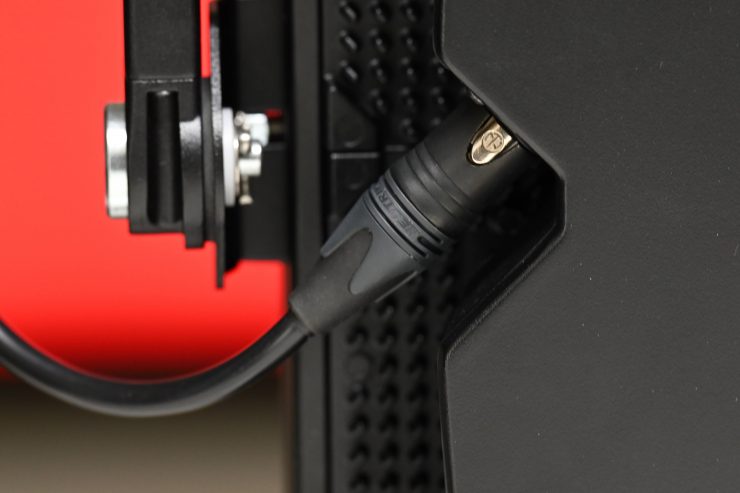
The Gemini 1×1 HARD draws 200W and can be run off mains power or by using an optional V-mount or Anton Bauer Gold Mount battery plate. This power draw is the same as the Lupo Superpanel Full Color 30 and ARRI S30-C Skypanel, but more than some of the other competing lights.
| Power Draw | |
| Litepanels Gemini 1×1 HARD | 200W (nominal) |
| Rotolight Titan X1 | 230W (nominal) |
| ARRI S30-C SkyPanel | 200W (nominal) |
| Litepanels Gemini 1×1 SOFT | 200W (nominal) |
| Rayzr MC 100 | 98W (nominal) |
| Lupo Superpanel 30 Full Color | 200W (nominal) |
| Luxli Timpani 1×1 RGBAW | 120W (nominal) |
| Aputure Nova P300C | 360W (nominal) |
Above you can see a power draw comparison between some of the competing lights.
This 200W power draw does mean that it can be used on location without mains power.
I did test out the light running on a camera battery and I was able to use it at 100% output without any problem.

The Litepanels single battery plate that is available attaches to the yoke frame. This costs $380 USD. It would have been nice to have seen an integrated battery plate comes with the fixture. $380 USD is a steep price to pay for a battery plate and it is way overpriced in my opinion.
What you do have to remember is that you will need to use a very high-capacity battery (above 200Wh) to power the light.
Beam Angle
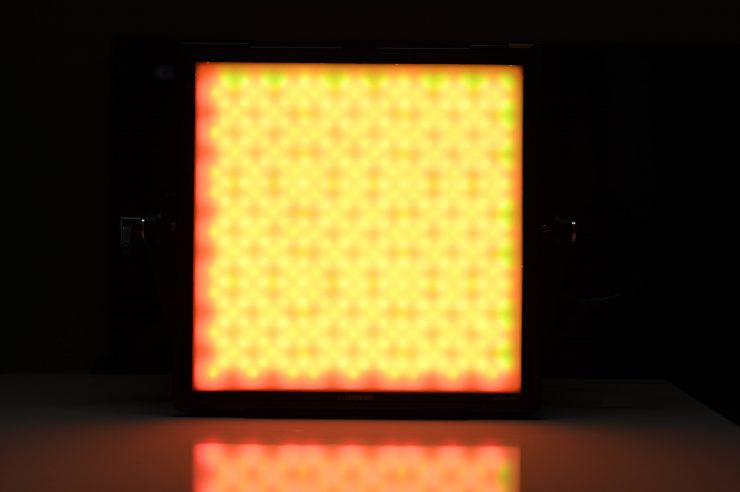
The Gemini 1×1 HARD has a 46° beam angle which is reasonably tight for a 1×1 fixture. As a comparison, the Gemini 1×1 SOFT has a beam angle of 95°.
Below you can see what the beam angle is of other competing lights:
| Beam Angle | |
| Litepanels Gemini 1×1 HARD | 46 degrees |
| Rotolight Titan X1 | 68 degrees to 150 degrees |
| ARRI SkyPanel S30-C | 110 degrees |
| Litepanels Gemini 1×1 SOFT | 95 degrees |
| Razyr 7 MC120 | 120 degrees |
| Lupo Superpanel 30 Full Color | 40 degrees |
| Lupo Superpanel 30 Full Color Soft | 115 degrees |
| Luxli Timpani 1×1 RGBAW | 78 degrees |
| Aputure NOVA P300c | 120 degrees |
With lights such as the ARRI SkyPanels, you can put accessories such as honeycomb grids, benders, and intensifier panels that will change the beam angle. Other lights also have the ability to change the beam angle through the use of various light modifiers.
Flicker-free
Litepanels claim that the Gemini is flicker-free at any frame rate or shutter angle. From the frame rates and shutter angles I tried, I found that to be true, but I was only able to test up to 240fps.
Firmware Upgradable
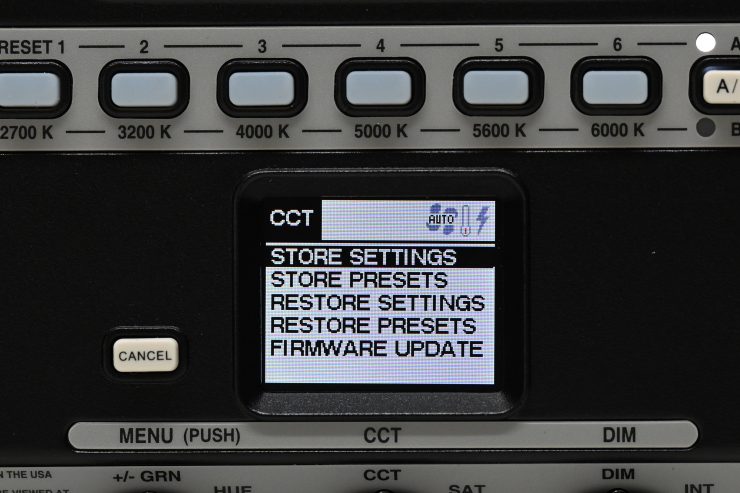
One of the nice features of the Gemini 1×1 HARD is that Litepanels will continue to add features to the light over time. There is a USB slot on the top of the light which can be used for updating the firmware on the Gemini as well as storing settings and presets.
Photometrics
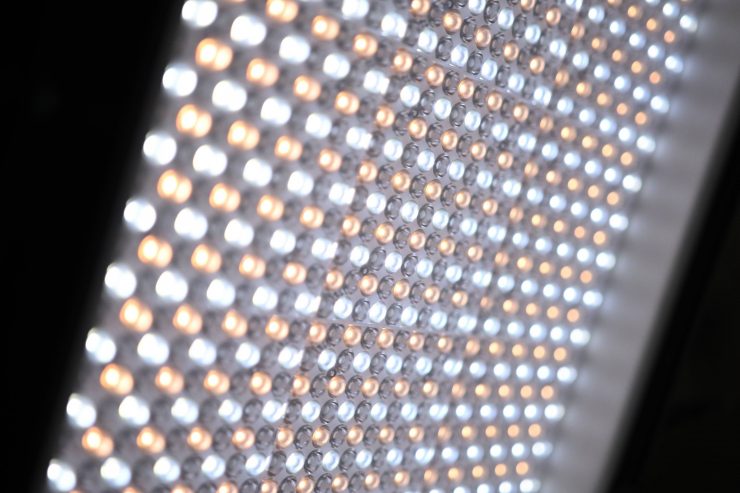
So now let’s get to the photometric results. I always test lights in this way so that I get a reference to how they compare to other fixtures. Results only tell part of the story and should never be used alone to judge a light. I have found from extensive testing over the years that certain lights that have good photometric results don’t always look good, and lights that have worse photometric scores can sometimes look better than their results indicate.
Output & Kelvin color temperature accuracy
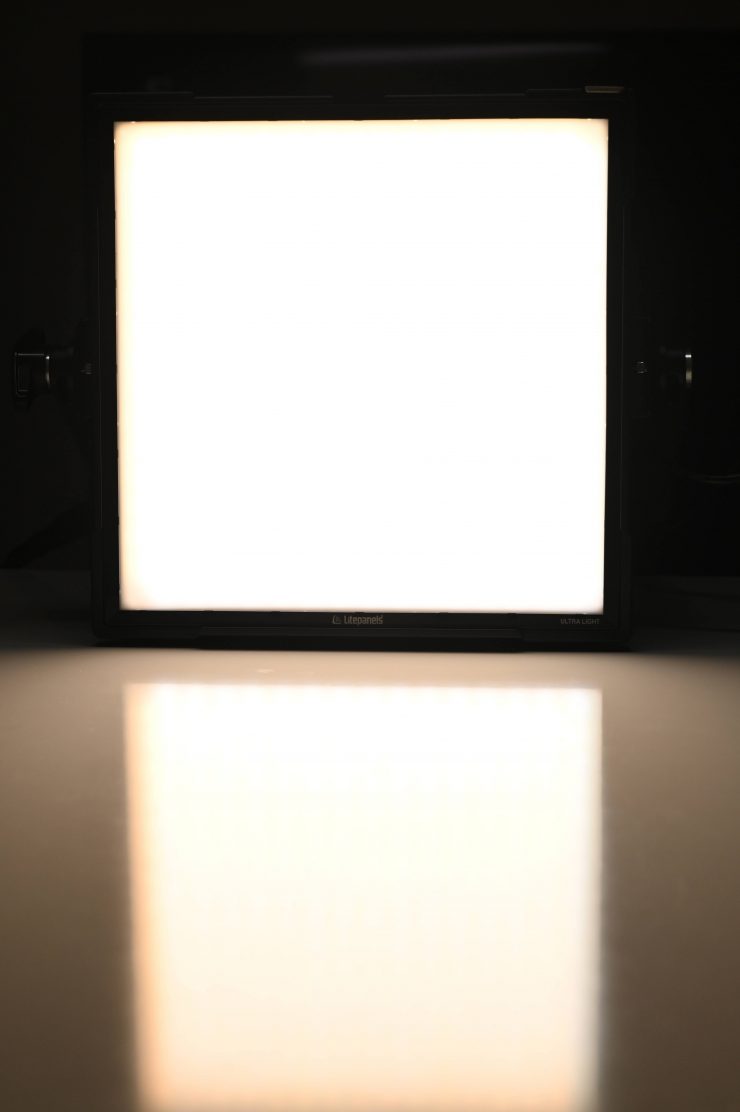
I tested the Gemini 1×1 HARD at a variety of Kelvin color temperatures with a Sekonic C-800 Spectrometer to find out how much output the light had and how accurate the Kelvin color temperature reproduction was. All readings are taken at a distance of 1m (3.28ft) in a controlled environment.
5600K (Ultra Light Diffusion)
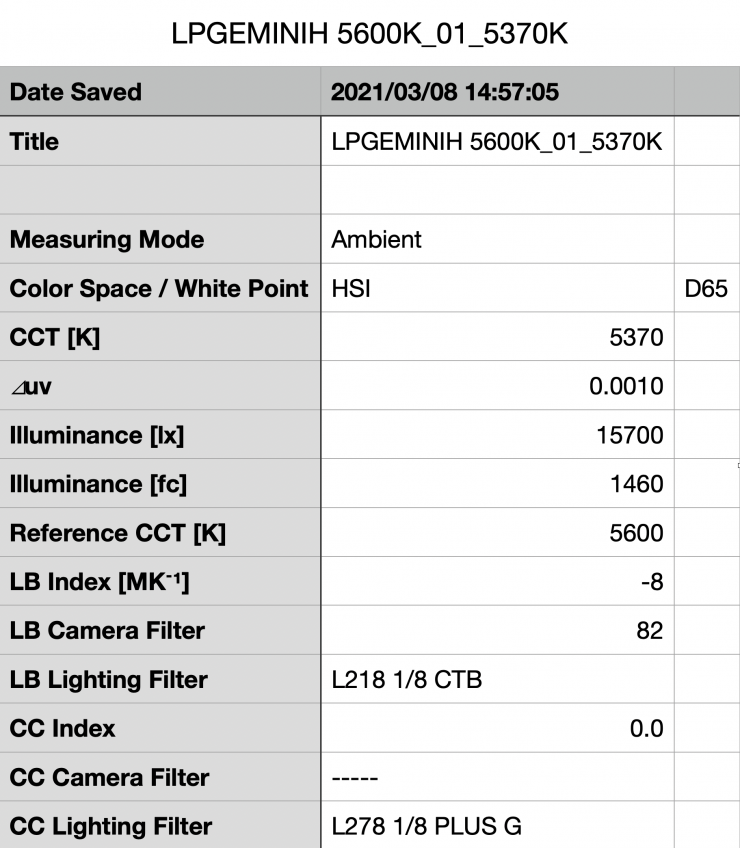
Above you can see the light recorded
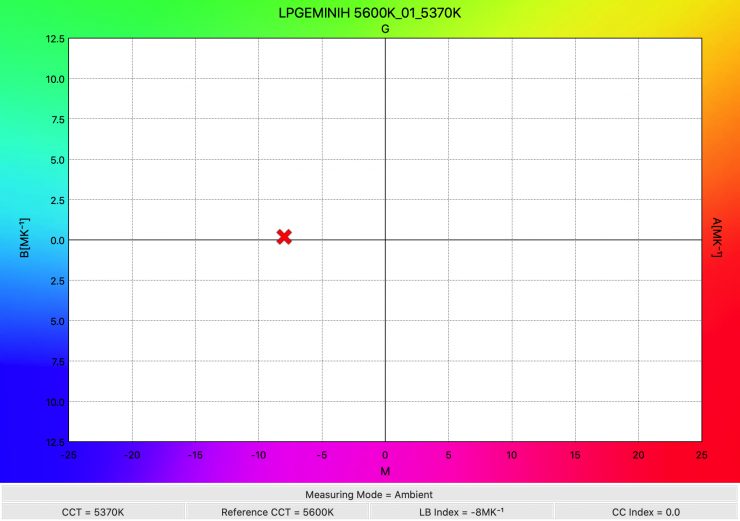
The Gemini produced a Kelvin color temperature of 5370K and it had a CC Index score of 0.1M.
For a 1×1 sized panel, the Litepanels Gemini 1×1 HARD certainly has a good amount of output., but you do need to remember that it has a quite tight beam angle of just 46°.
How does this compare to some other 1×1 RGB lights that we have previously reviewed:
| Output at 5600K | |
| Litepanels Gemini 1×1 HARD (Ultra Light Diffusion) | 15700 lx |
| Rotolight Titan X1 | 8210 lx (no diffusion) |
| ARRI S30-C SkyPanel | 5950 lx* |
| Litepanels Gemini 1×1 SOFT | 6260 lx |
| Lupo Superpanel 30 Full Color Soft | 4380 lx |
| Lupo Superpanel 30 Full Color | 16900 lx |
| Luxli Timpani 1×1 RGBAW | 3380 lx |
| Aputure NOVA P300c | 9600 lx |
- *An optional intensifier panel is available.
As you can see only the Lupo Superpanel Full Color 30 has more output, however, that light doesn’t feature any type of front diffusion panel.
Now, you need to be acutely aware that some of these lights have a built-in diffusion panel and some don’t, some have tighter beam angles than others, and quite a few of the lights have different power draws.
You should also know that the output from the Gemini 1×1 HARD when you don’t use any diffusion is considerably higher than any other 1×1 RGBWW fixture I have ever tested. More on that further done in this section.
As far as an accurate rendition of creating a 5600K source here is how some of the other 1×1 RGB lights that we have previously reviewed fare:
| Kelvin Color Temperature (when set at 5600K) | |
| Litepanels Gemini 1×1 HARD | 5370K |
| Rotolight Titan X1 | 5512K |
| ARRI S30-C SkyPanel | 5821K |
| Litepanels Gemini 1×1 SOFT | 5645K |
| Lupo Superpanel 30 Full Color Soft | 5423K |
| Lupo Superpanel 30 Full Color | 6322K |
| Luxli Timpani 1×1 RGBAW | 5367K |
| Aputure NOVA P300c | 5426K |
The Litepanels Gemini 1×1 SOFT is still the most Kelvin color-accurate 1×1 panel light I have ever tested at 5600K. The new Gemini 1×1 HARD was more than 200K off being an accurate 5600K source.
5600K (Dome Diffuser)
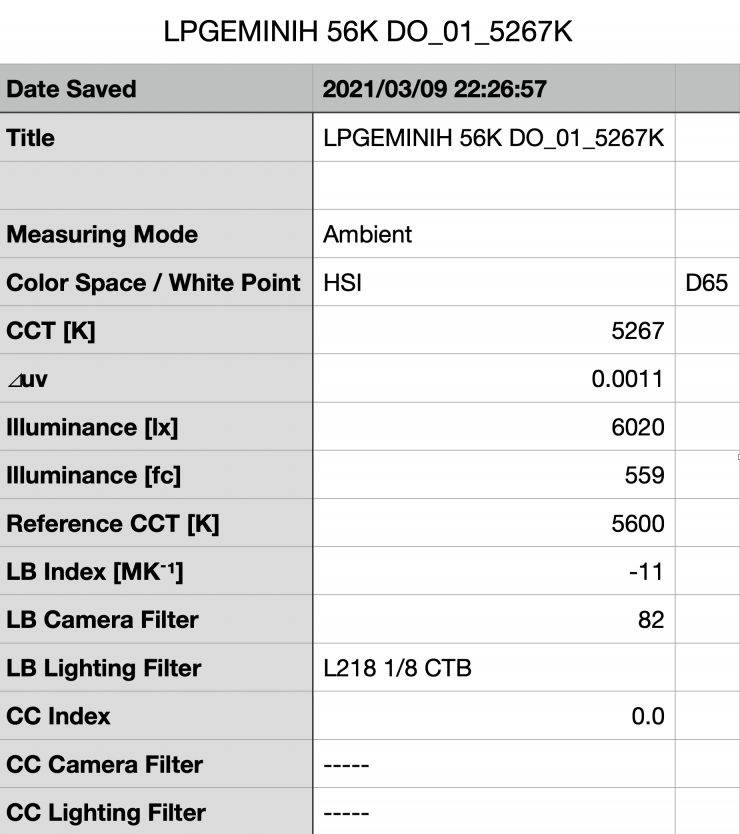
The Gemini 1×1 HARD also ships with a Dome Diffuser. Above you can see that the light recorded
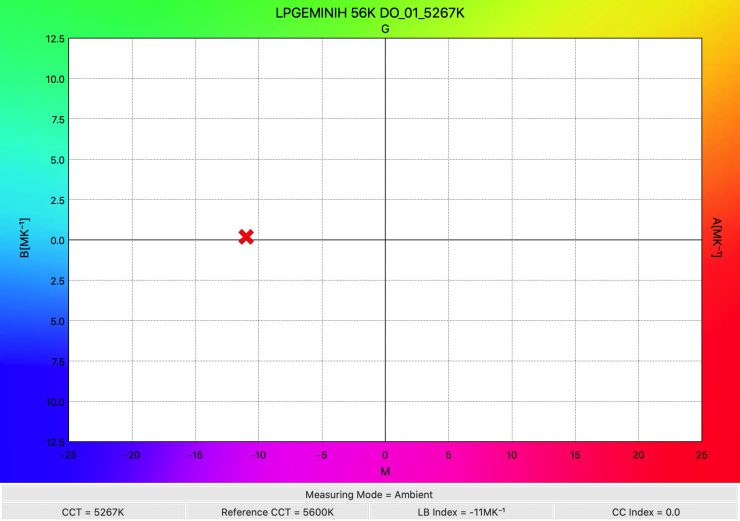
The Gemini produced a Kelvin color temperature of 5267K as opposed to the 5370K it recorded when just the Ultra Light Diffusion was used. Interestingly, the light registered a CC Index score of 0.0 which was better than the 0.1M it registered when just the Ultra Light Diffusion was used.
6020 lx is still a lot of output from a heavily diffused 1×1 fixture.
5600K (No Diffusion)
The Gemini 1×1 HARD also has the ability to be used without any diffusion. You can remove the Ultra Light Diffusion panel from the front of the fixture.
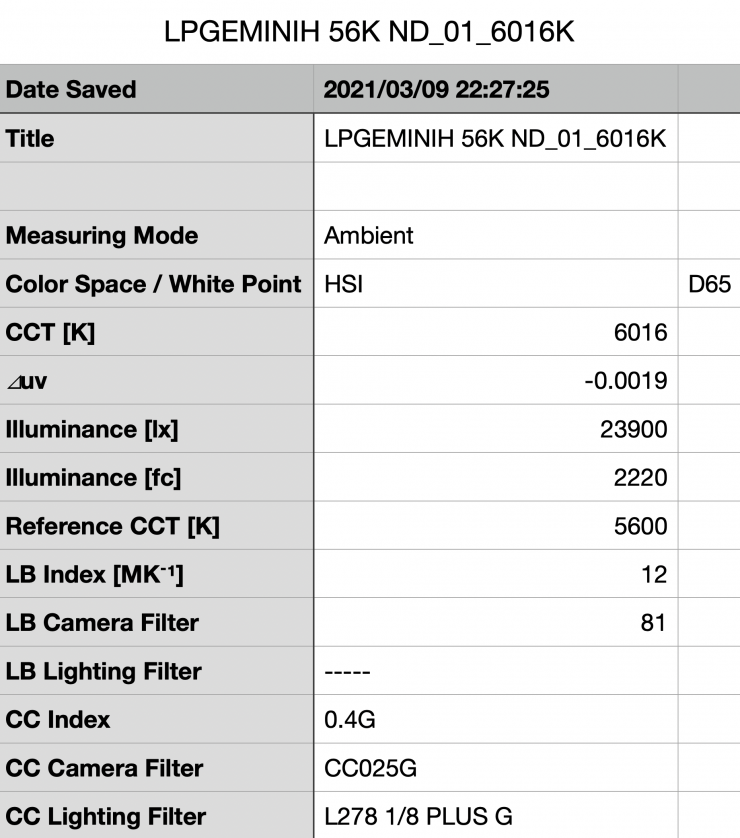
Above you can see that in this configuration the light recorded
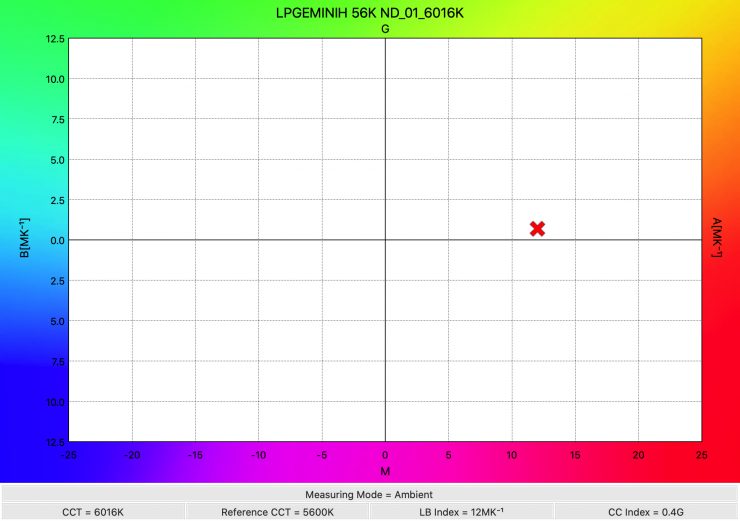
The Gemini used without any diffusion produced a Kelvin color temperature of 6016K as opposed to the 5370K it recorded when the Ultra Light Diffusion was used. The light also registered a CC Index score of 0.4G which was a lot worse than the 0.1M it registered when the Ultra Light Diffusion was used.
This shows me that the Ultra Light Diffusion is certainly changing the Kelvin color temperature quite dramatically. Without the Ultra Light Diffusion, the Gemini’s Kelvin color temperature when set at 5600K is considerably cooler and it leans towards green.
23900 lx is a ton of output and this makes it the highest output 1×1 RGBWW light I have ever tested by quite some considerable margin. Again. you need to be very aware that this light has quite a tight beam angle.
3200K
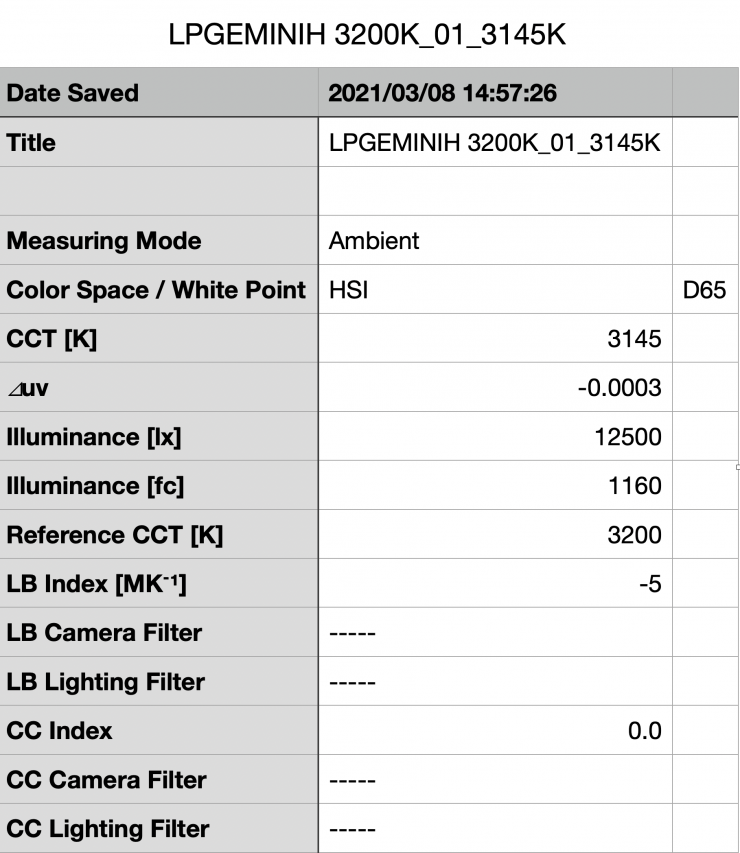
Above you can see the lights output when it was set at 3200K. It produced 12500 lx (1160 fc), which was 20.3% less than the 15700 lx it produced at 5600K.
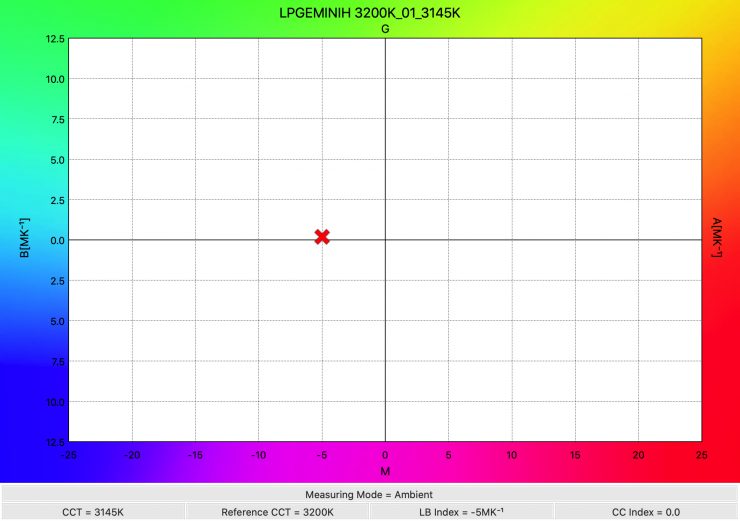
As far as Kelvin color temperature accuracy goes, it recorded a very accurate reading of 3145K. The fixture had a CC reading of 0.0.
Even though at 3200K it has less output than when used at 5600K, 12500lx is still an impressive figure from a 1×1 sized panel.
How does this compare to some other 1×1 RGBWW lights that we have previously reviewed:
| Output at 3200K | |
| Litepanels Gemini 1×1 HARD | 12500 lx |
| Rotolight Titan X1 (no diffusion) | 8480 lx |
| ARRI S30-C SkyPanel* | 5530 lx |
| Litepanels Gemini 1×1 SOFT | 5480 lx |
| Lupo Superpanel 30 Full Color Soft | 4150 lx |
| Lupo Superpanel Full Color | 13900 lx |
| Luxli Timpani 1×1 RGBAW | 3480 lx |
| Aputure NOVA P300c | 8500 lx |
*The SkyPanel has an optional intensifier panel available that increases the output but narrows the beam angle to 74°.
Again these results are a little deceptive because all of these lights have different beam angles.
As far as an accurate rendition of creating a 3200K source here is how some of the other 1×1 RGB lights that we have previously reviewed fare:
| Kelvin Color Temperature | |
| Litepanels Gemini 1×1 HARD | 3145K |
| Rotolight Titan X1 | 3150K |
| ARRI S30-C SkyPanel | 3269K |
| Litepanels Gemini 1×1 SOFT | 3273K |
| Lupo Superpanel 30 Full Color Soft | 3065K |
| Lupo Superpanel Full Color | 3181K |
| Luxli Timpani 1×1 RGBAW | 3380K |
| Aputure NOVA P300c | 3087K |
The Litepanels Gemini 1×1 HARD, Rotolight Titan X1, ARRI S30-C SkyPanel, and Litepanels Gemini 1×1 were all fairly close. Ironically, the high output Lupo Superpanel 30 Full Color had the most accurate reading of 3181K.
How does it perform at various Kelvin color temperatures?
Summary of results
| OUTPUT | KELVIN COLOR TEMPERATURE READING | |
| 2700K | 10100 lx | 2637K |
| 3200K | 12500 lx | 3145K |
| 4500K | 15800 lx | 4326K |
| 5600K | 15700 lx | 5370K |
| 6500K | 13100 lx | 6069K |
| 8000K | 11400 lx | 7195K |
| 10000K | 10800 lx | 8764K |
These results show me that the lights output is very consistent at 4500K and 5600K, however, it does start to vary quite a lot once you start going below 4500K and above 5600K. The light had the most output when it was used at 4500K. The output varies by 36% from the highest to the lowest figures I recorded. I was actually expecting the light to be a little more consistent when it came to output across its Kelvin color temperature range.
These results show me that the light drops output when you start moving the Kelvin temperature dial both down and up from 4500K. The output of the light is extremely impressive and it actually has a lot higher output than the ARRI SkyPanels SC30-C. In saying that, it’s important to note that the ARRI has a much wider 115° beam angle, compared to the Gemini’s 46°. The Litepanels also has significantly more output than both the Lupo Superpanel Full Color 30 and Luxli Timpani.
The results also show me that the light is not particularly accurate when it comes to Kelvin color temperature reproduction, particularly once you start moving above 5600K. The light is at its most Kelvin color-accurate when used at 4500K and below.
Does the light’s Kelvin color consistency change once it is dimmed down?
With a lot of LED lights, the Kelvin color temperature can change significantly once you start dimming the fixture down. So how does the Litepanels Gemini 1×1 HARD fair? Below you can see the performance of the light.
| CCT | |
| 100% Output | 5370K |
| 75% Output | 5313K |
| 50% Output | 5313K |
| 25% Output | 5338K |
| 10% Output | 5369K |
| 5% Output | 5363K |
As you can see the light’s Kelvin color temperature does not alter in any significant way even when the light is dimmed down to 5%. The consistency of the Kelvin color temperature when dimming down the fixture was exceptional.
How linear is the output?
I wanted to see how linear the light’s output was when used at 5600K. Below you can see the results.
| lx | |
| 100% Output | 15700 lx |
| 75% Output | 12200 lx |
| 50% Output | 8190 lx |
| 25% Output | 4120 lx |
| 10% Output | 1640 lx |
| 5% Output | 805 lx |
The results show me that the light’s output is reasonably linear once you start dimming the fixture down. At 50% output, it had 47.8% less output than when it was used at 100% output. At 25% output the Gemini 1×1 HARD had 73.7% less output than when it was used at 100%. This shows me that the light’s output is very linear.
Watts vs Output
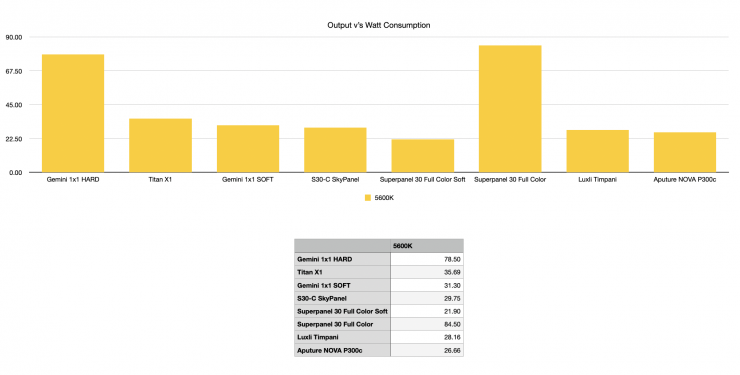
In terms of watts vs output, above you can see a comparison table showing the amount of output compared to the power draw of all of the lights. Now, they all don’t have an identical beam angle, so please keep that in mind. Given the beam angle, the Litepanels Gemini 1×1 HARD has by far the most output of any of the lights above.
Color Rendering
5600K
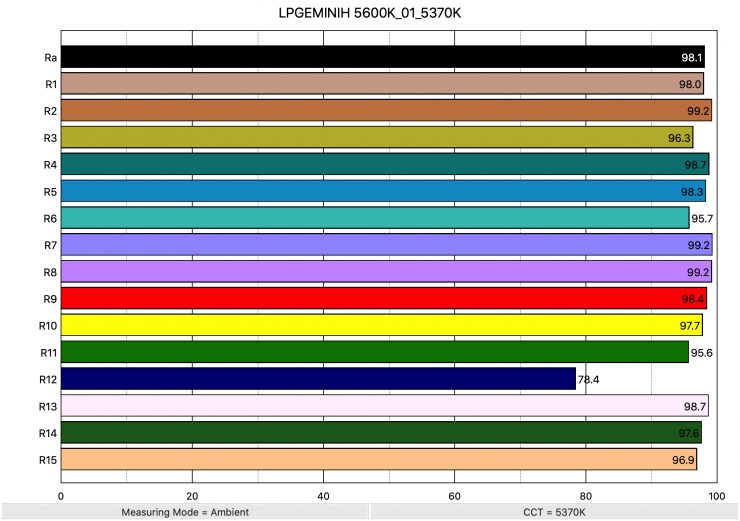
So now that we have seen how much output the Gemini 1×1 HARD produces, how does it perform when it comes to replicating accurate colors. Above you can see that when the light was set at 5600K it recorded an average CRI (R1-R8) of 98.1 and an extended CRI (R1-R15) of 96.52. For replicating accurate skin tones it recorded for R9 98.4 (red), 98.7 for R13 (closest to caucasian skin tones), and 96.9 for R15 (closest to Asian skin tones). These were outstanding results.
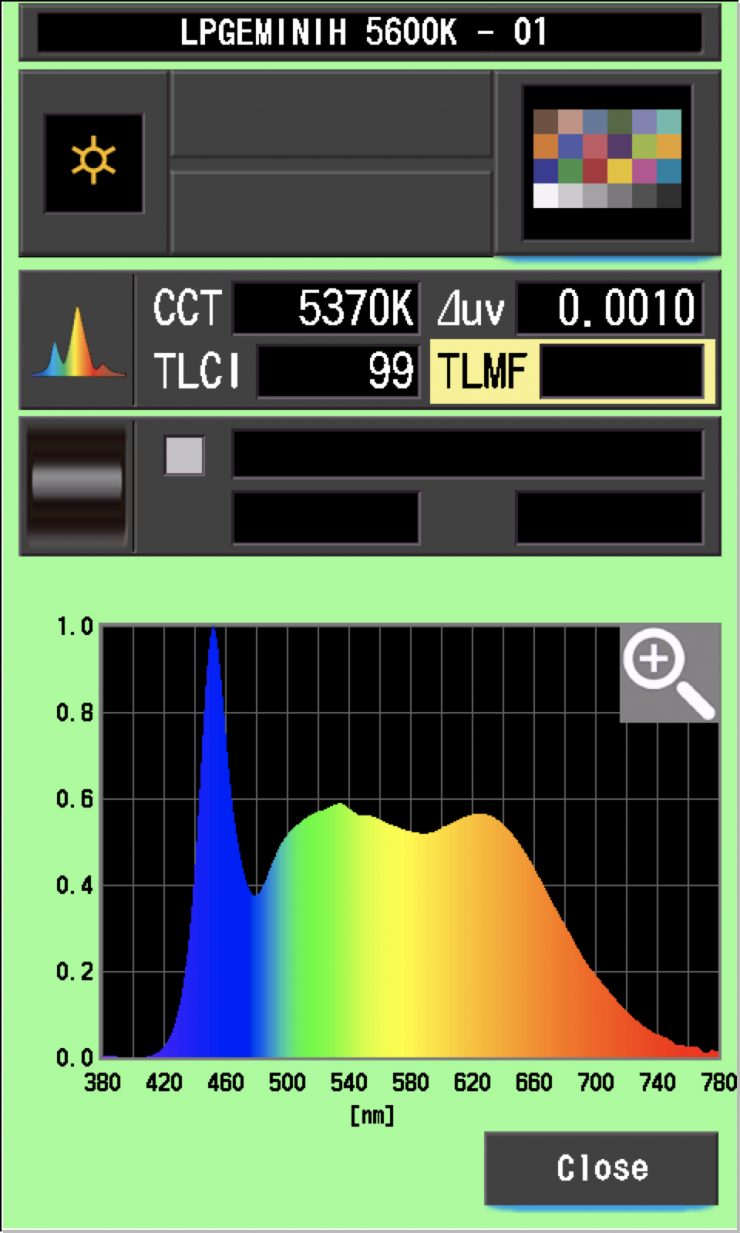
When used at 5600K the light recorded a TLCI score of 99.
How does this compare to some other 1×1 RGB lights that we have previously reviewed when used at 5600K? Below you can see:
| Extended CRI | |
| Litepanels Gemini 1×1 HARD | 96.52 |
| Rotolight Titan X1 | 95.44 |
| ARRI SkyPanel S30-C | 93.39 |
| Litepanels Gemini 1×1 SOFT | 91.32 |
| Lupo Superpanel 30 Full Color Soft | 93.4 |
| Lupo Superpanel 30 Full Color | 93.59 |
| Luxli Timpani 1×1 RGBAW | 96.2 |
| Aputure NOVA P300c | 95.34 |
The Litepanels Gemini 1×1 HARD had the best 5600K color rendering scores I have seen from any 1×1 RGBWW light.
3200K
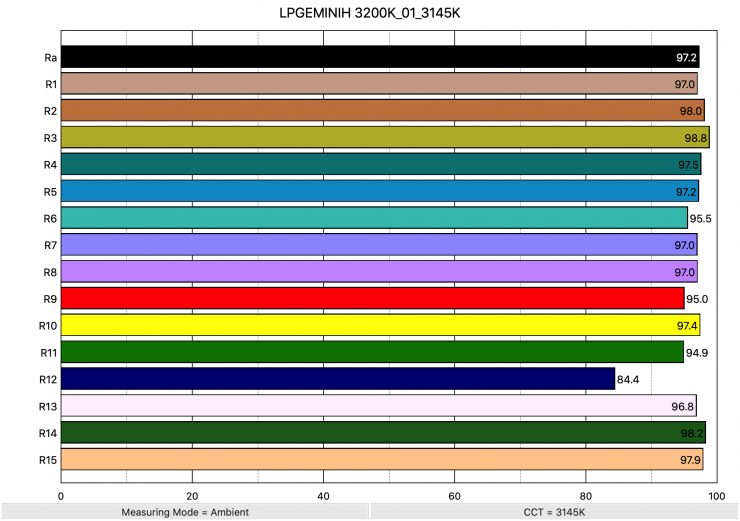
Above you can see the scores for when the light was used at 3200K. It recorded an average CRI (R1-R8) of 97.2 and an extended CRI (R1-R15) of 93.22. For replicating accurate skin tones it recorded 95.0 for R9 (red), 96.8 for R13 (closest to caucasian skin tones), and 97.9 for R15 (closest to Asian skin tones).
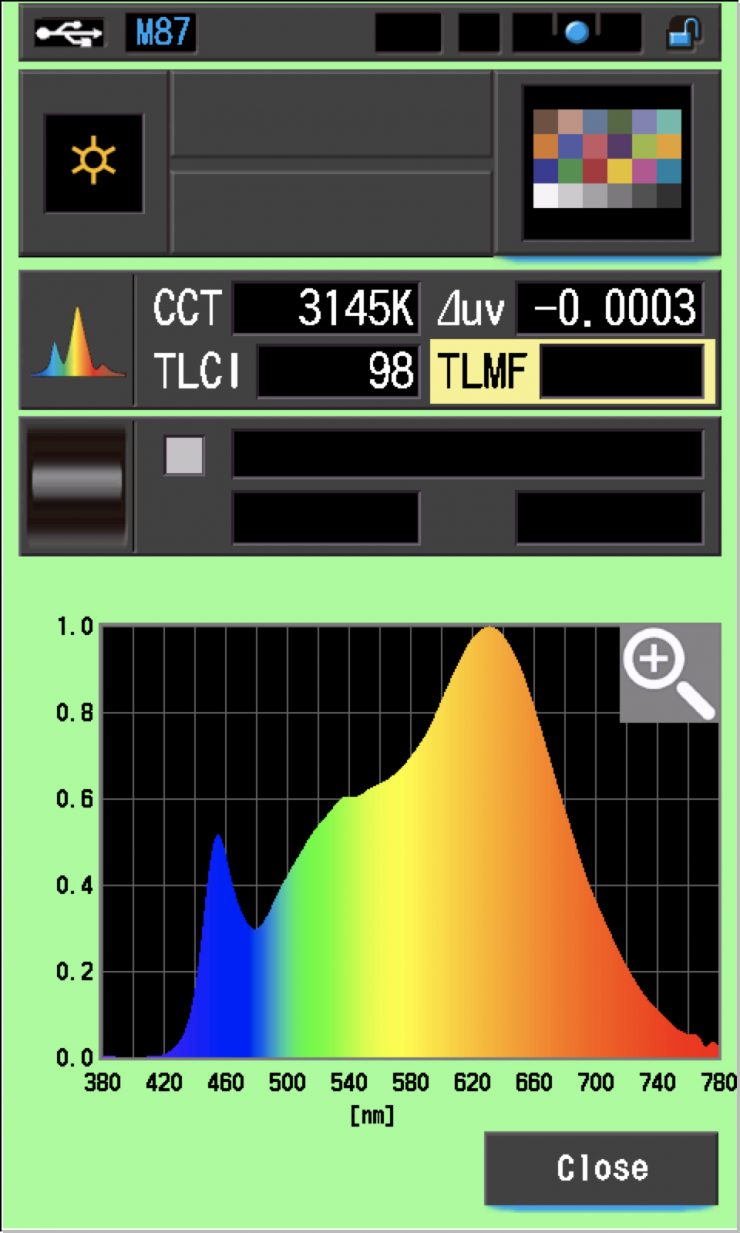
When used at 3200K the light recorded a TLCI score of 98.
While these results were pretty good, they weren’t quite as good as those I recorded when using the light at 5600K.
How does this compare to some other 1×1 RGB lights that we have previously reviewed when used at 3200K? Below you can see:
| Extended CRI | |
| Litepanels Gemini 1×1 HARD | 93.22 |
| Rotolight Titan X1 | 91.83 |
| ARRI SkyPanel S30-C | 93.56 |
| Litepanels Gemini 1×1 SOFT | 93.32 |
| Lupo Superpanel 30 Full Color Soft | 91.86 |
| Lupo Superpanel 30 Full Color | 90.7 |
| Luxli Timpani 1×1 RGBAW | 95.45 |
| Aputure NOVA P300c | 95.64 |
The Aputure NOVA P300c has the highest Extended CRI score when used at 3200K of any of the lights wee have tested.
Thoughts on Color Accuracy
The Litepanels Gemini 1×1 HARD scored extremely well at 5600K, but not as well at 3200K. However, the scores at 3200K didn’t actually affect real-world performance. It just goes to show you that you should never judge a product based on technical results alone.
What you clearly need to understand, and I want to continue to stress this point, is that all lights react differently to different camera and sensor combinations. One particular light may look better with an ARRI camera, and another light may look better with a Canon camera, etc.
Don’t read too much into CRI scores because they rarely tell the whole story of any light.
CC Index & ⊿uv
The CC Index displays the CC correction value and whether any magenta or green need to be added or subtracted. 1 CC corresponds to 035 Kodak CC values or 1/8 Rosco filter values. Any reading less than +1.00 or -1.00 and you’re probably not going to need to make any kind of adjustment. The ⊿uv is the value to show how much this light is away from being an ideal light source (black body radiation = incandescent lamp). As with the CC Index you want this number to theoretically be zero. Kelvin is not a linear value, so we need to convert from Kelvin to MK-1 to compare the values of color temperature. To calculate from Kelvin to Mired is MK-1= 1*1000000/Kelvin. While this may sound confusing, it is the only way of measuring if the Kelvin shift is significant enough to warrant having to use a filter for correction. Below are the results for the Litepanels Gemini 1×1 HARD.
Kelvin Vs MK-1
| Kelvin | Difference in K | MK-1 | Difference in MK-1 | |
| SET VALUE | 2700K | 0 | 370.37 | 0 |
| ACTUAL READING | 2637K | 64 | 379.21 | 8.84 MK-1 |
| SET VALUE | 3200K | 0 | 312.5 | 0 |
| ACTUAL READING | 3145K | 55 | 317.96 | 5.46 MK-1 |
| SET VALUE | 4500K | 0 | 222.22 | 0 |
| ACTUAL READING | 4326K | 174 | 231.16 | 8.94 MK-1 |
| SET VALUE | 5600K | 0 | 178.57 | 0 |
| ACTUAL READING | 5370K | 230 | 186.21 | 7.64 MK-1 |
| SET VALUE | 6500K | 0 | 153.84 | 0 |
| ACTUAL READING | 6069K | 431 | 164.77 | 10.93 MK-1 |
| SET VALUE | 8000K | 0 | 125 | 0 |
| ACTUAL READING | 7195K | 805 | 138.98 | 13.98 MK-1 |
| SET VALUE | 10000K | 0 | 100.00 | 0 |
| ACTUAL READING | 8764K | 49 | 114.10 | 14.10 MK-1 |
These figures might look confusing, but what it tells me is that the light is reasonably Kelvin color-accurate from 2700K up to 5600K. Any MK-1 score that is under -9/9 means you wouldn’t have to use any color correction gels. The MK-1 scores for this light were just ok. At 6500K and above the light is not very Kelvin color accurate.
CC INDEX & ⊿uv
| CC INDEX | ⊿uv | |
| 2700K | 0.3G | -0.0021 |
| 3200K | 0.0 | -0.0003 |
| 4500K | 0.0 | -0.0001 |
| 5600K | 0.0 | 0.0010 |
| 6500K | 0.0 | 0.0012 |
| 8000K | 1.0G | -0.0053 |
| 10000K | 0.8G | -0.0010 |
These scores are exceptionally good. The consistency of the Litepanels Gemini 1×1 HARD, especially at 3200K to 6500K is very impressive. At 8000K and 10000K the light’s accuracy does fall away.
TM-30
TM-30 is a relatively new color rendering standard that was developed to deal with the limitations of CRI. TM-30 looks at 99 individual colors. These 99 colors are categorized into seven groups: nature, skin color, textiles, paints, plastics, printed material, and color systems.
TM-30 scores go from 0 – 100. The higher the score, the more accurate a light is at producing colors. Any TM-30 Rf score in the ’90s is considered to be good. What is interesting and something that you need to be very aware of is that two separate light sources with the exact same CRI scores can render colors very differently. A light with a high CRI rating could have a low TM-30 score. Conversely, a light with a good TM-30 score could have a bad CRI score.
Now, there are two measurements associated with TM-30, Rf and Rg.
- Rf (Color Fidelity)
- Rg (Color Gamut)
With Rf value, ideally you want a score in the 90’s.
With Rg value, a score below 100 indicates that the light source renders colors with less saturation than the reference source. So ideally you want this score to be above 100.
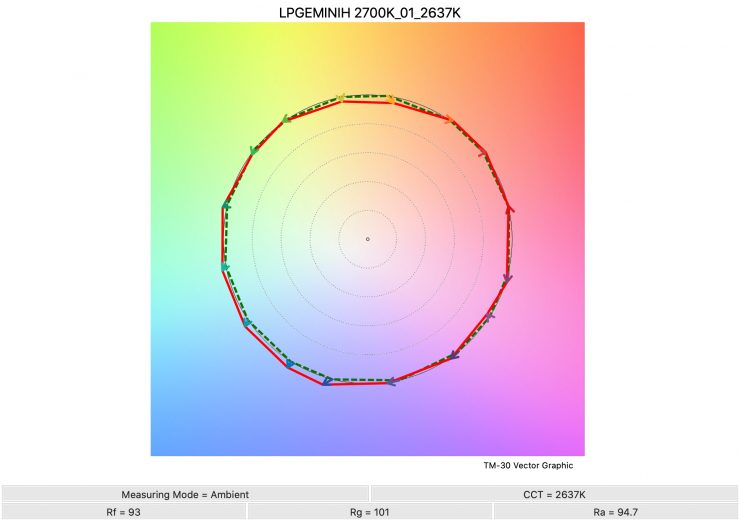
Above you can see the scores for the Litepanels Gemini 1×1 HARD at various Kelvin color temperatures.
| Rf (Color Fidelity) | Rg (Color Gamut) | |
| 2700K | 87 | 96 |
| 3200K | 87 | 99 |
| 4500K | 93 | 100 |
| 5600K | 94 | 101 |
| 6500K | 93 | 100 |
| 8000K | 87 | 99 |
| 10000K | 87 | 96 |
SSI
SSI (Spectral Similarity Index) was developed by the Sci-Tech Council of the Academy. SSI gives me the ability to set any light as a standard, or use predefined standards (such as CIE D55), and then give other lights an SSI score based upon how well they will match.
Standards such as CIE D55 measure spectral response and compare it directly against an ideal light source.
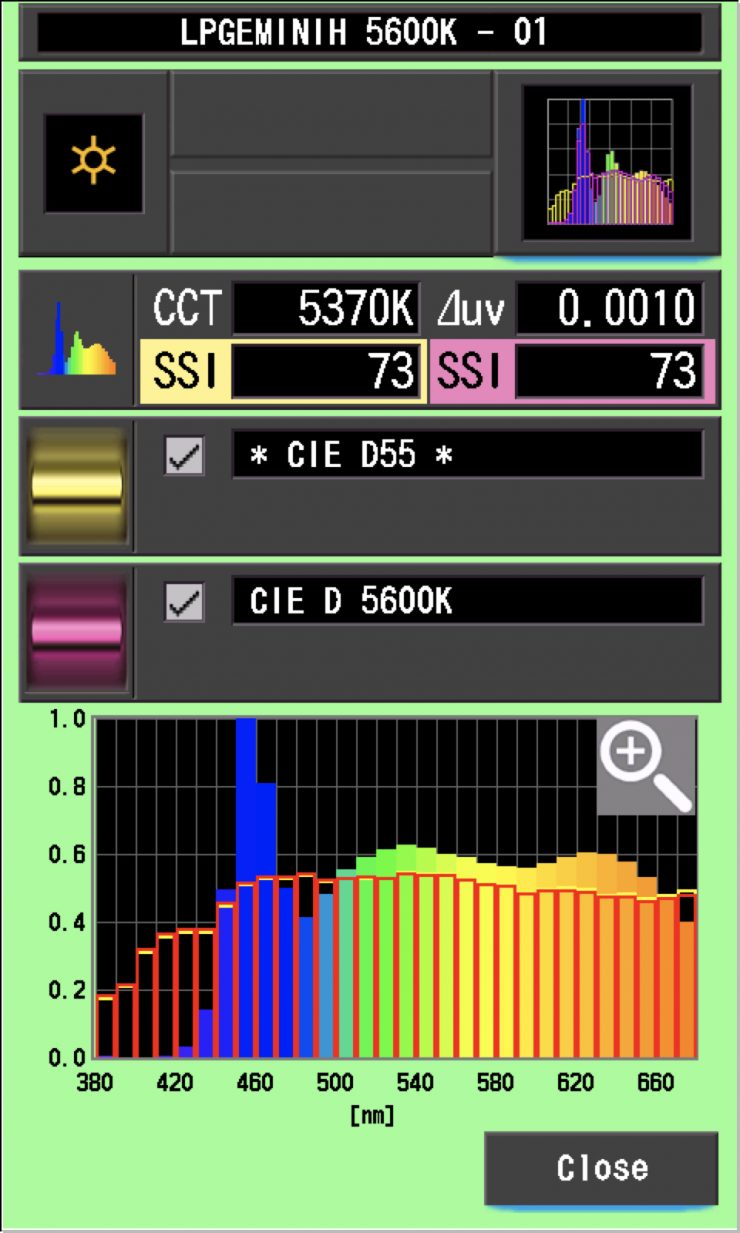
In the above graph above the gold bars indicate a perfect CIE D55 source. The red bars indicate a perfect CIE D 5600K source. This lets us compare how close to a perfect 5600K lighting source the Litepanels Gemini 1×1 HARD is. A score in the low 70’s is typical for a 5600K LED source.
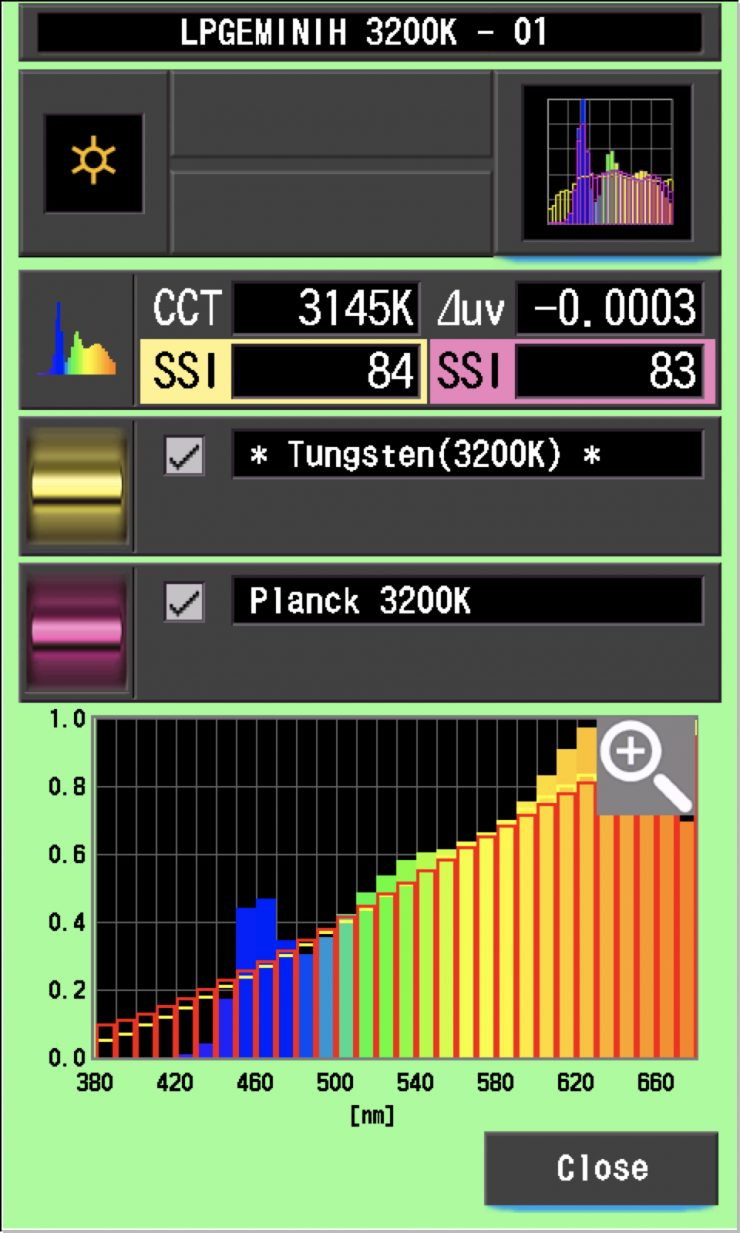
In the above graph, the red bars indicate a perfect Planck 3200K source. The gold bars indicate a perfect 3200K Tungsten source. This lets us compare how close to a perfect 3200K lighting source the Litepanels Gemini 1×1 HARD is. Any SSI score in the ’80s is very good for a 3200K LED light. As you can see, LED lights have a hard time replicating colors below about 450nm.
The main reason we want to record SSI scores is so we can see how well they match with other lights. As a test, I was curious to see how well the Litepanels Gemini 1×1 HARD matched the Litepanels Gemini 1×1 SOFT. I theory both of these lights should match very closely.
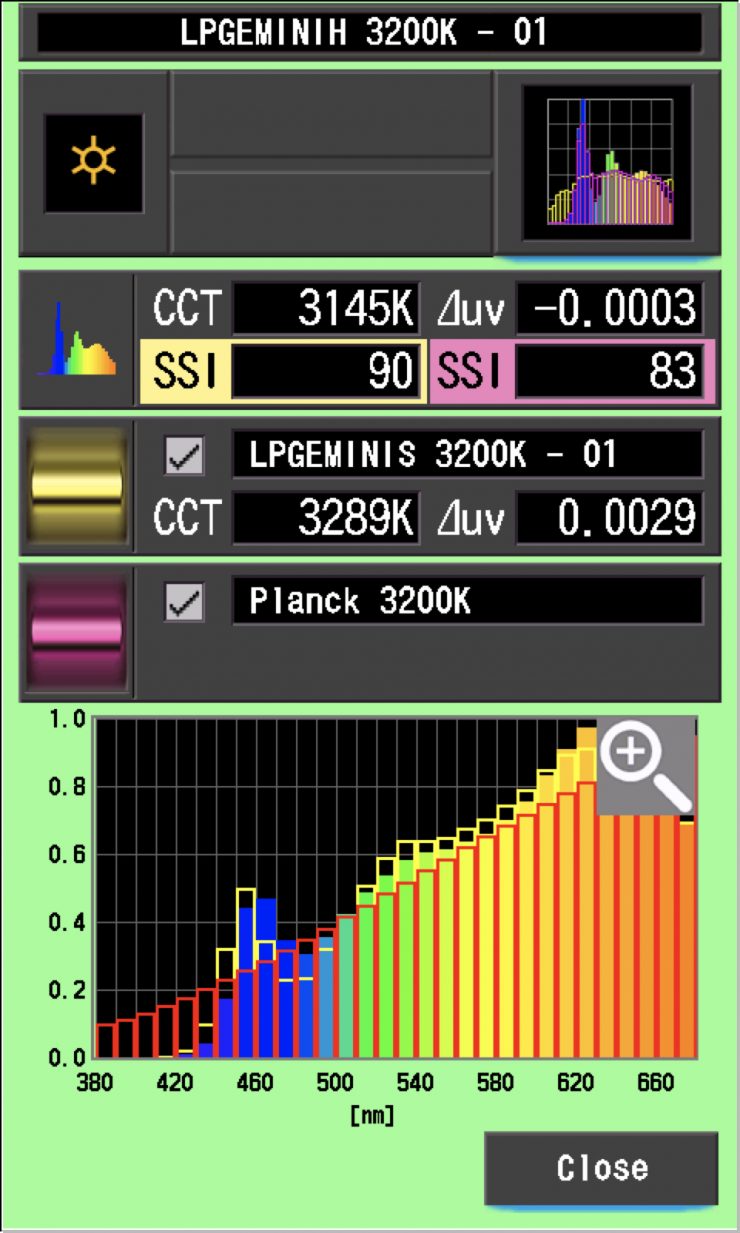
Above you can see that the Gemini 1×1 HARD and SOFT do not actually match that well. This shows me that Litepanels have had to make some compromises to get much more output from the HARD version. I would have expected a closer match than this, but this is why we do SSI tests.
I also wanted to see how well the Gemini 1×1 HARD matched an ARRI Orbiter and an Intellytech LC160 II. Below you can see the results when the lights are set at both 5600K and 3200K.
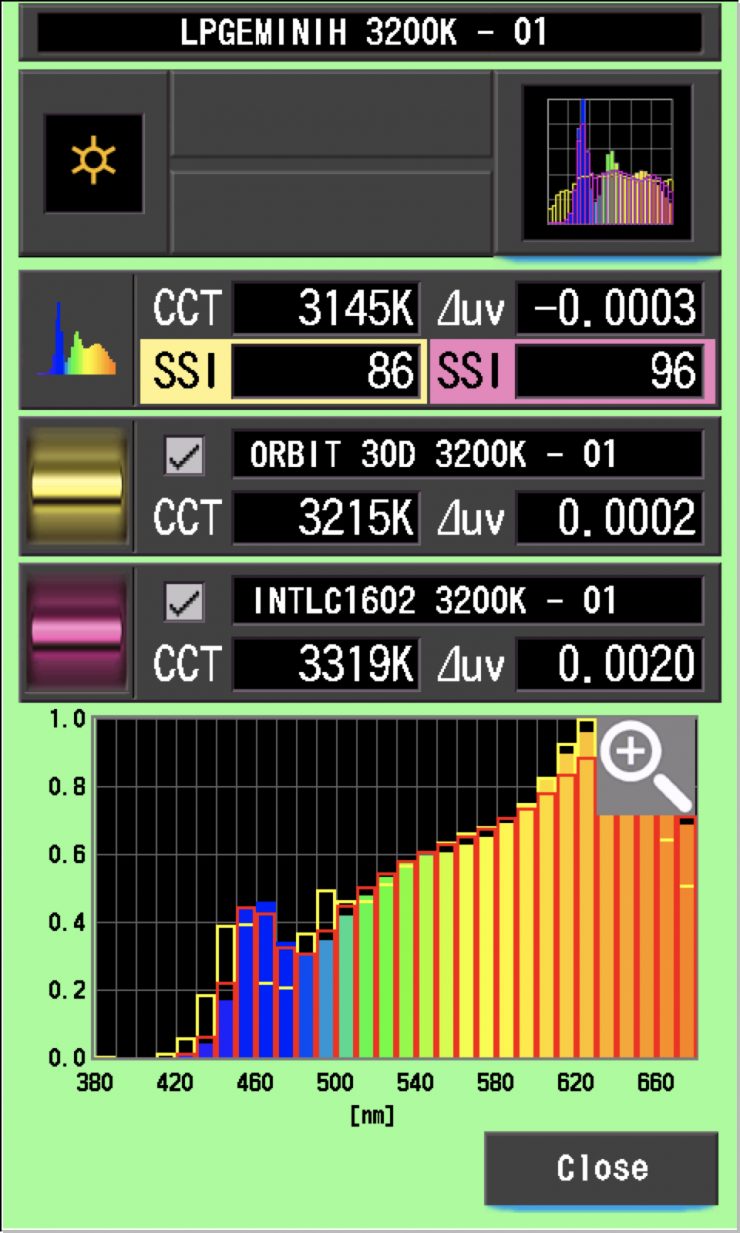
As you can see the Litepanels matches the Intellytech at 3200K really well. At 5600K it is still reasonably good with a score of 92.
SPECTRAL DISTRIBUTION
5600K
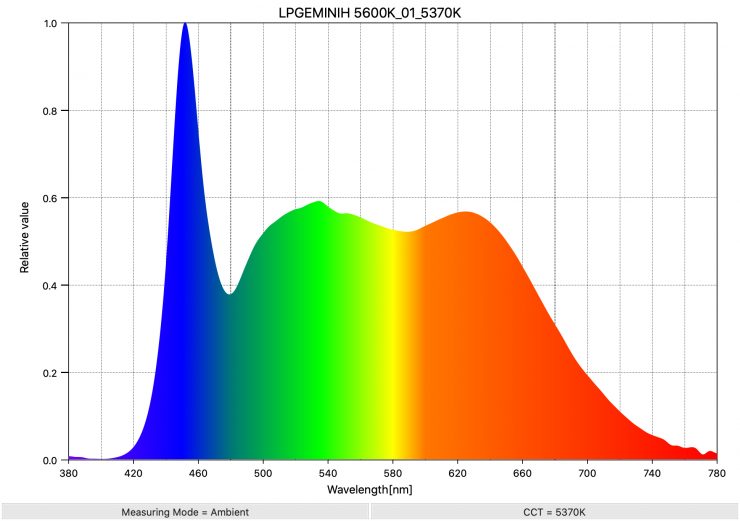
Above you can see the spectral distribution of the Gemini 1×1 HARDwhen it is set at 5600K. The spectral distribution is pretty good at 5600K and the light doesn’t have any large green spikes. This spectral distribution is one of the better examples I have seen from a LED light at 5600K, and it’s fairly consistent with other Litepanels LED fixtures such as the Astra 1×1 series and the larger Gemini 2×1.
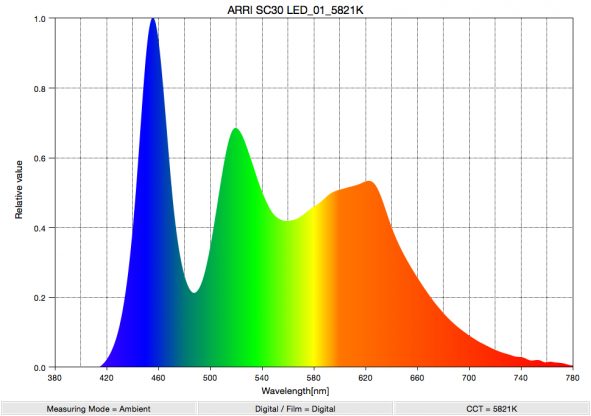
As a comparison, above you can see the spectral distribution of the ARRI S30-C SkyPanel when it is set at 5600K. The spectral distribution is not nearly as good as the Gemini and the light has a very big green spike and is missing significant color information throughout the spectrum.
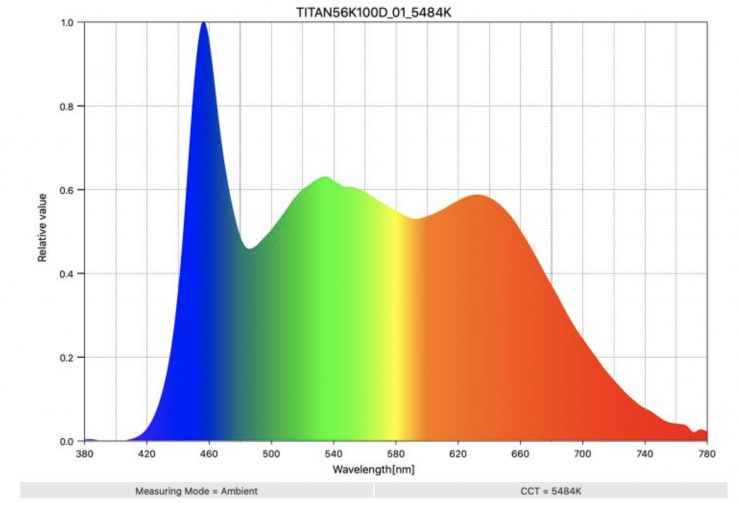
As another comparison, above you can see the spectral distribution of the Rotolight Titan X1 when it is set at 5600K. The Rotolight has a very similar spectral response to the Litepanels.
3200K
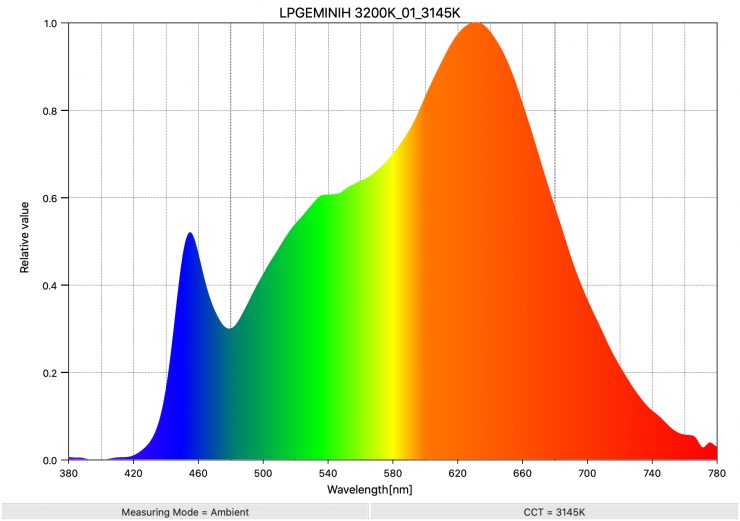
Above you can see the spectral distribution of the Gemini 1×1 HARD when it is set at 3200K. The spectral distribution is excellent at 3200K and the light only has a very slight push towards green. This spectral distribution is one of the best I have seen from a LED light at 3200K.
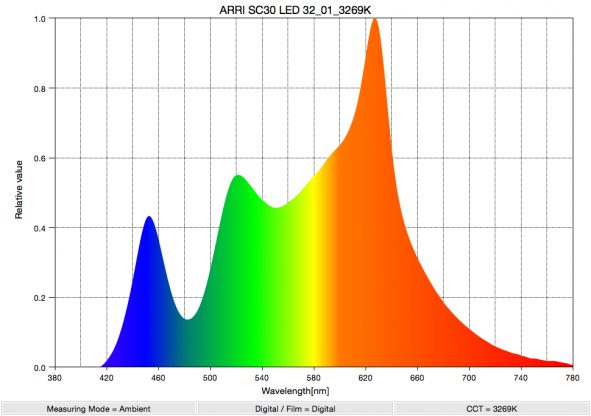
Above you can see the spectral distribution of the ARRI S30-C SkyPanel when it is set at 3200K. The spectral distribution is not nearly as good as the Gemini and the light has a very big green spike and is missing significant color information throughout the spectrum.
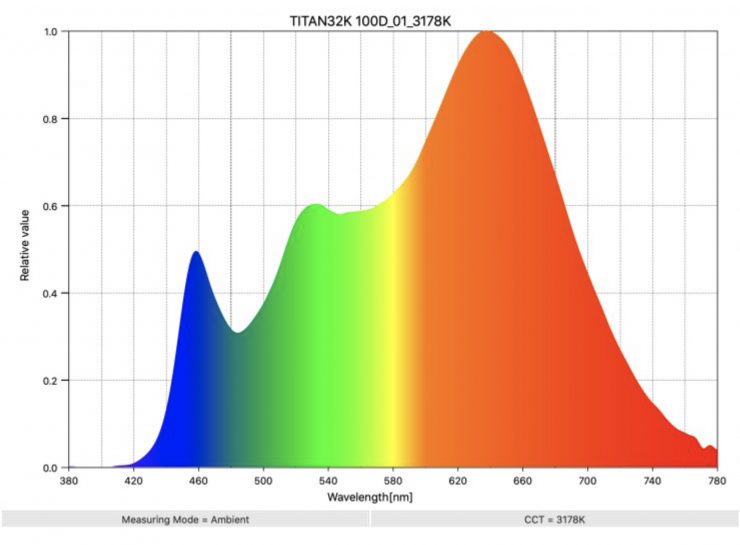
Above you can see the spectral distribution of the Rotolight Titan X1 when it is set at 3200K.
Real World performance & quality of light
As I always say, photometric scores only tell you part of the story. So photometric scores aside, how does the Litepanels Gemini 1×1 HARD perform in the real world? I found that the quality of light was right up there with the nicest I have seen from any 1×1 style RGBWW panel.
It certainly helps that it has a high output and a diffusion panel. The soft source being emitted is very flattering on skin tones, and you get nice soft shadows. Whatever the engineers have been doing over at Litepanels, they seem to have been doing it right.
I was impressed by how well the Gemini performs. It’s a very versatile lighting tool that offers a lot of functionality. As the light has a high output it can be used for a variety of lighting applications. Despite having a fairly tight beam angle of 46-degrees it has enough output to create a rather large soft lighting source if you punch it through diffusion or use it with a softbox.
I found that as an interview key light it looked really nice if you added a softbox and an egg crate. As the light already has a removable diffusion panel, if you add another layer of diffusion you get very soft light.
You can also just use the diffusion panel and the Diffusion Dome to create a nice soft source without the need for a softbox.
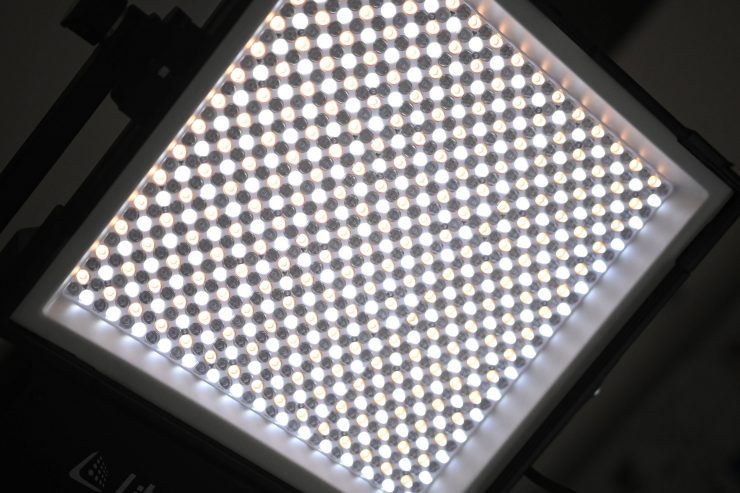
Conversely, if you want a lot of output and you want a hard source of light you can just use the fixture without any diffusion.
All of the 1×1 style RGBWW lights I have tested perform well and in a lot of cases your splitting hairs in terms of which light looks better. There really isn’t one light that jumps out and declares itself the winner. That’s why, in my opinion, it is going to be a hard sell for Litepanels. With quite a few other options from manufacturers costing significantly less than the Gemini 1×1 HARD, how do you convince potential buyers to part with more money? The ace up its sleeve is definitely the high amount of output and the fact that Litepanels has been able to achieve that output without increasing the power draw.
Almost every 1×1 RGBWW light being released these days has effects, HSI, CCT, and Gel modes. To set your light apart you really need to do something different from the competition.
Price
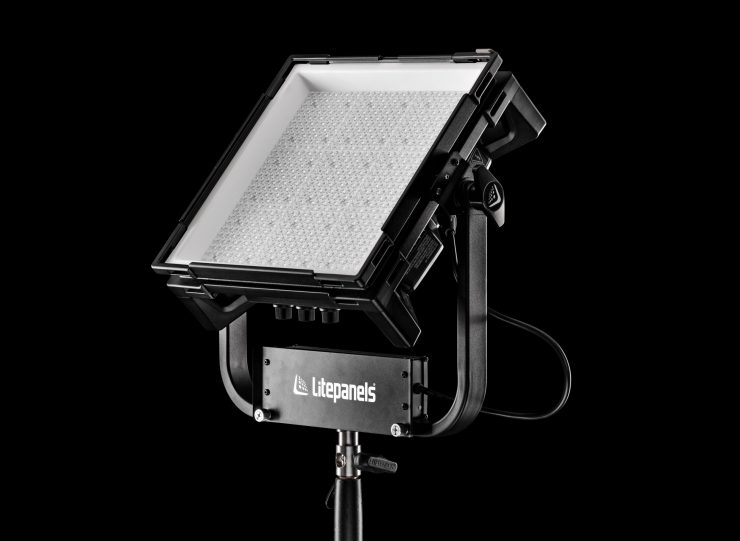
The Gemini 1×1 HARD will retail for $2,250 USD, £1,600GBP, or 1,850EUR depending on where you live. This is a lot of money to spend on a light, but it is cheaper than the ARRI SC30-C SkyPanel ($4,213 USD), Rotolight Titan X1 ($2,699 USD), and the BB&S Area 48 Color ($3,300 USD).
Even though the Gemini 1×1 is being targeted as competition to the ARRI, I personally think the lights other competition is more likely to come from the Lupo Superpanel Full Color 30 ($1,598 USD)
You do have to take into account that if you want to run the Gemini 1×1 HARD off camera batteries you will need the optional Litepanels V-Mount or Anton Bauer Gold Mount Battery Bracket which is an additional $380 USD.
Full Specifications
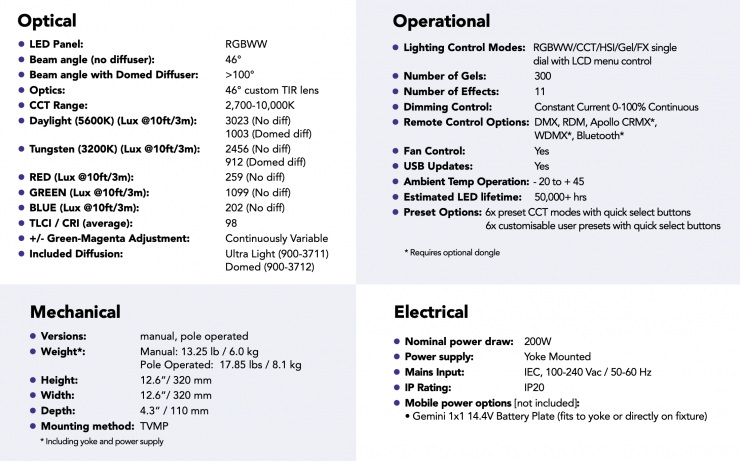
Optional Extras
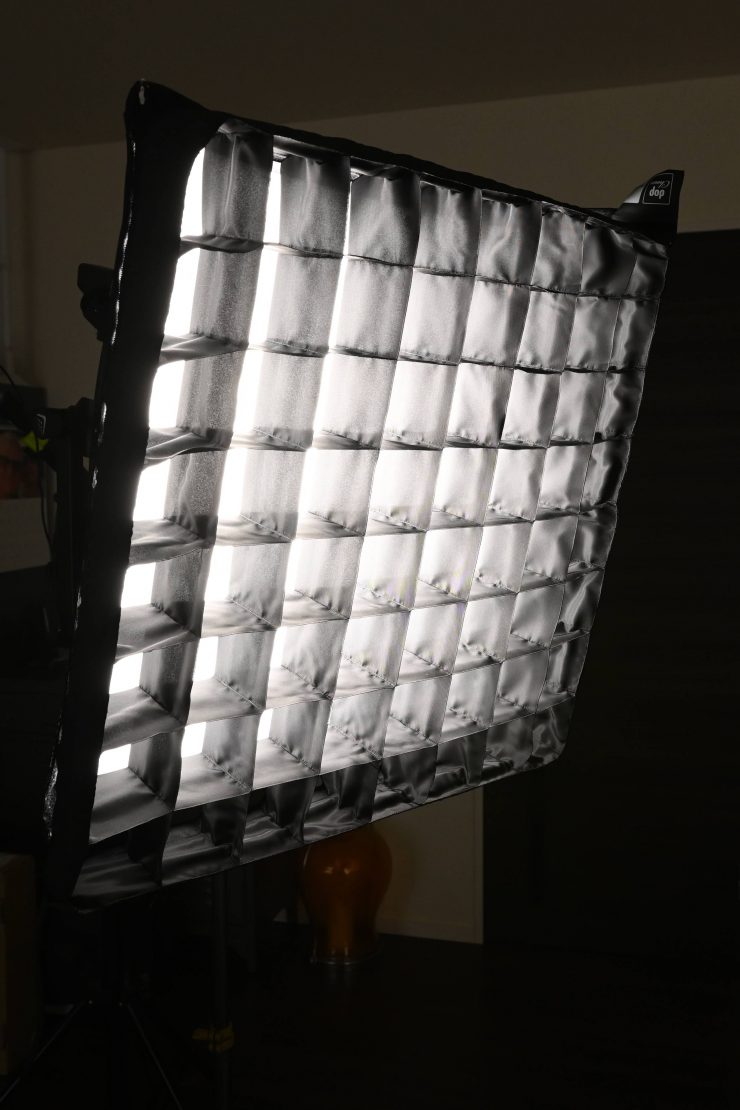
The Gemini 1×1 HARD comes with the yoke and a power cable, as well as a removable diffusion panel and a Diffusion Dome. If you need a battery plate or a softbox you are going to have to factor in the cost of other accessories you may need.
I tried out the Gemini 1×1 HARD with the DoPchoice Snapbag, and a 40° Snapgrid Eggcrate, and they worked really well. They enabled me to create a softer source and suppress spill very easily.
Accessories available include:
- Gemini 1×1 Diffuser Heavy
- Gemini 1×1 Diffuser Medium
- Gemini 1×1 Diffuser Lite
- Gemini 1×1 Intensifier
- 60° honey comb grid
- 40° Snapgrid Eggcrate
- 4 way Barndoors
- Dual Gemini 1×1 Array Kit with Yoke
- Quad Gemini 1×1 Array with Yoke
- Fixture Cover
- Hard Case
- Soft Carry Case
- Litepanels Snapbag Softbox for Gemini
- Snapbag Cloth set for Litepanels Gemini Softbox
- Battery Plate Gold Mount
- Battery Plate V-Mount
Who is the Gemini 1×1 HARD aimed at?
You could use the Gemini HARD for lots of different applications, but it’s certainly being targeted as a high-quality, high-output, travel-friendly, power-efficient lighting source to take on the road. 1×1 fixtures are still incredibly popular and Litepanels latest offering is sure to appeal to anyone who is in the market for a high quality, high output 1×1 RGBWW light. Its high output and ability to be run off a camera battery makes it very suitable for news crews, EFP work, and anyone else who is looking for a powerful, feature-rich 1×1 panel.
Other Alternatives
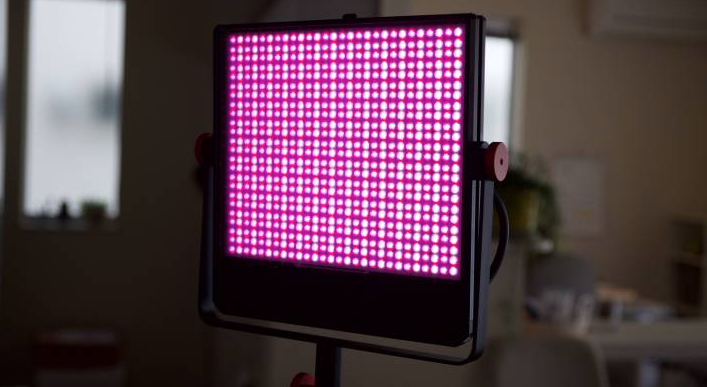
As I have already mentioned the ARRI SC30-C SkyPanel and the Rotolight Titan X1 are the Gemini’s closest competitors. However, there are some other alternative RGBWW options available such as the Lupo Superpanel Full Color 30,
If you don’t need all the features like Effects Mode, Colour Mode, or even CCT adjustment then there are plenty of other more value-friendly alternatives available. If you are simply just after a 1×1 light that is highly portable and provides pretty accurate color rendition then there are a plethora of choices available.
Conclusion
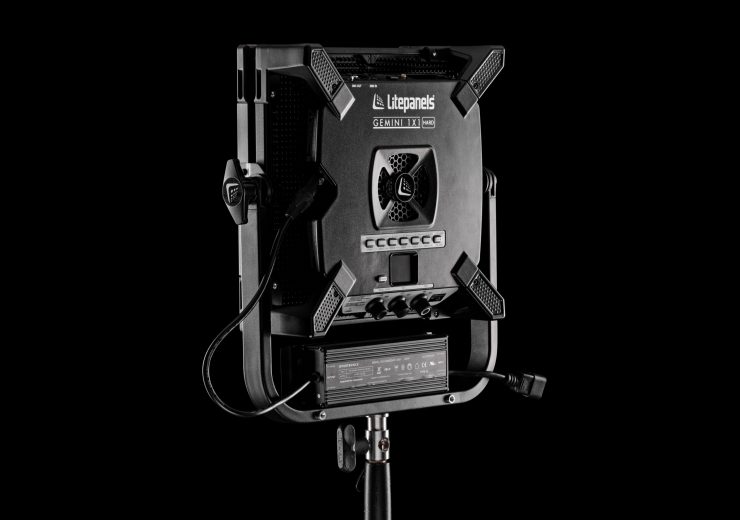
The Gemini 1×1 HARD is expensive at $2,250 USD, but it’s also around $2,000 USD cheaper than the ARRI SC30-C Skypanel. It is, however, considerably more expensive than the Lupo Superpanel Full Color 30,
The Litepanels Gemini 1×1 HARD produces a really nice quality of light. While its Kelvin color temperature accuracy wasn’t quite as good as expected, it didn’t seem to make any difference to the performance of the light.
The output surprised me and this is certainly one very bright 1×1 fixture. That brightness does, however, come at the expense of a tighter beam angle.
The ability to use the light with or without the Ultra Light Diffusion panel, or with the included Dome Diffuser makes it extremely versatile. This ability strengthens its appeal.
If you have been looking at an ARRI SC30-C SkyPanel or a Rotolight Titan X1, the Gemini 1×1 HARD makes for a very compelling alternative.
The Gemini 1×1 HARD has an impressive output, good build quality, and a nice range of features.
It would have also been nice to see a power draw that let you run the light off a single camera battery that was below 160Wh. In saying that, most of the competition also draws around 200W, and given the high output of the Gemini, Litepanels would have had to make the light less powerful if it drew less power.
Do I need these extra features and RGBWW capabilities? Probably not, but they are nice to have. Is it a practical light for solo shooters, yes I think it certainly is. While I could certainly see myself traveling with this light, it still requires the use of one very high-capacity battery if you want to power it remotely, and it is heavier than say the offerings available from Lupo, Luxli, Rayzr, and BB&S.
In all honesty, if you don’t need all of the extra features that
At $2,250 USD it is more expensive than a lot of the competition. Yes, I know Litepanels is aiming it directly at the ARRI Skypanel S30-C, but it still has to compete against other options that are already on the market.
From testing a lot of other RGBWW panels the Gemini 1×1 HARD is certainly right up there at the top of the pack, and I would probably take it over an S30-C SkyPanel given the price difference. Would I, however, take it over some of the other options that are available? That, I’m not so sure.
It’s a hard sell trying to convince someone that they could buy one Gemini 1×1 HARD for the same price that they could get 3 Luxli Timpani panels for. In saying that, it does have significantly more output than just about any of the other 1×1 sized RGBW and RGBWW lights that I have tested.
While the Gemini 1×1 HARD is certainly a very good fixture, it does face very stiff competition from more affordable offerings that are on the market and new lights such as the Rotolight Titan X1. If you were a previous user of the Litepanels Astra series and want to step up to an RGBWW light that has a ton of output, then it is certainly worth looking at.

